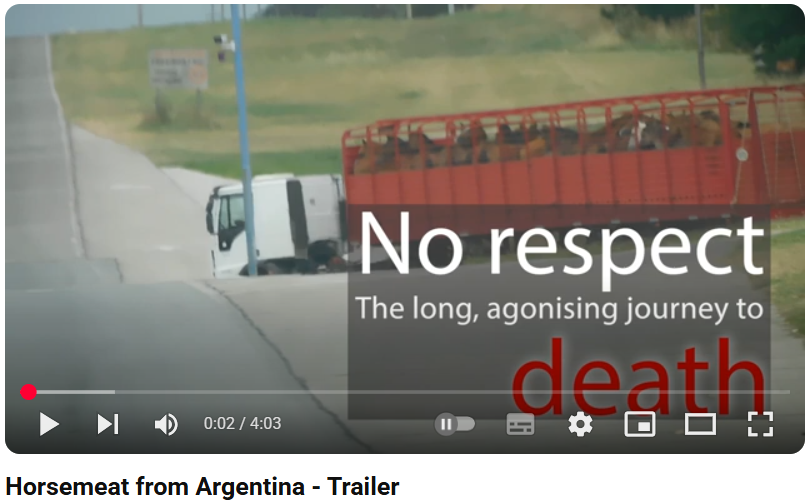The War on Animals
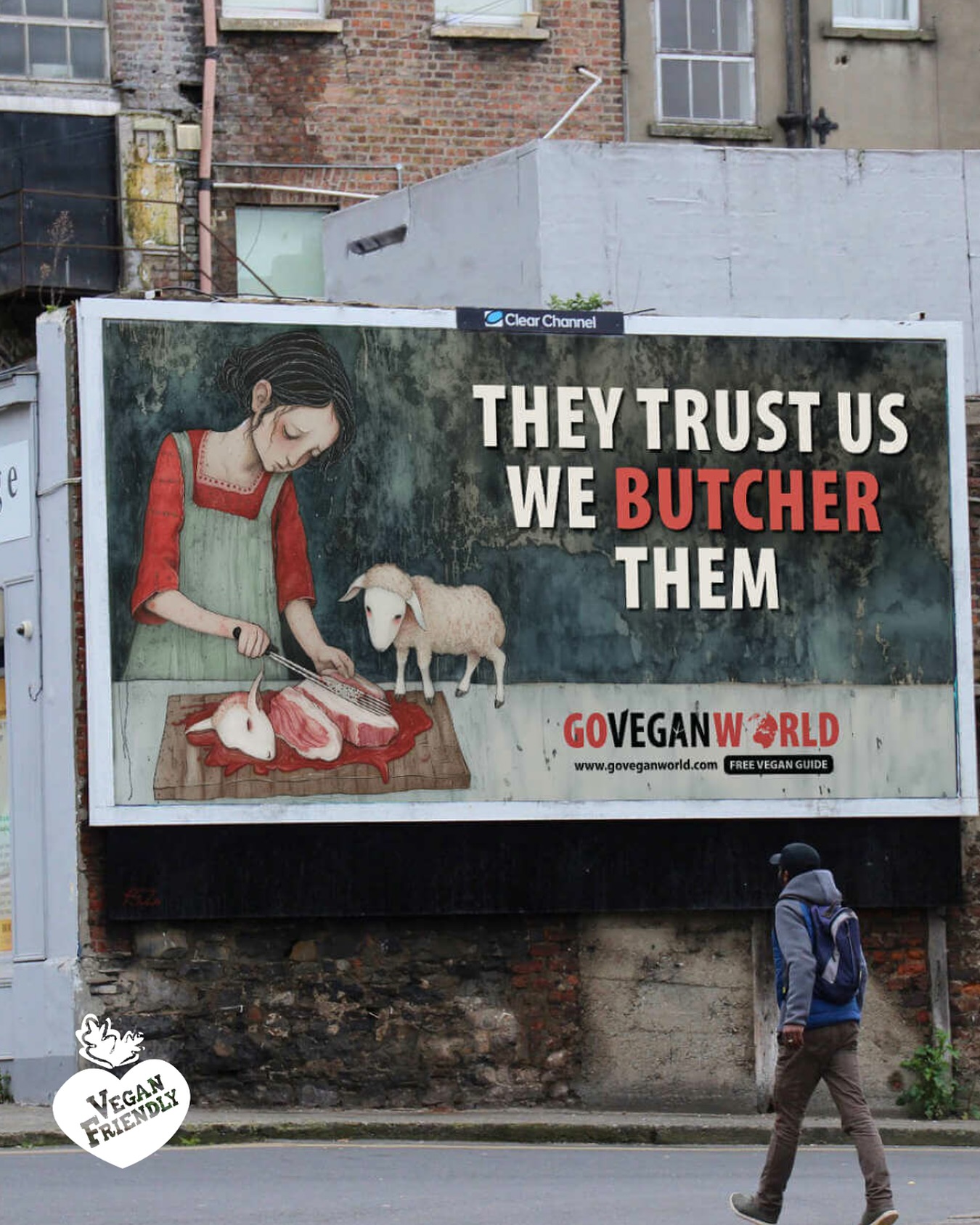
Live a life that reflects your true beliefs
When a child kills an animal for fun, we fear mental illness. When an adult with the capacity to reason does it, we call it 'sport'. When children are small, we want them to eat healthy—greens and fruit—but when they grow up, suddenly veganism is seen as 'extreme.' True compassion doesn't age; it applies to all beings at every stage of life.
We often hear phrases like "humane slaughter," as if the violent taking of an animal's life could ever be kind or just. But consider the absurdity: would anyone accept "humane rape," "humane child molestation," or a "humane holocaust"? These ideas are rightly rejected because the harm they describe is fundamentally incompatible with humanity or compassion. So why do we accept the notion of "humane slaughter" for animals?
This is a classic case of cognitive dissonance—our minds trying to hold two opposing beliefs at once. We love animals and want to protect them, yet we support systems that cause unimaginable suffering under the guise of necessity or tradition. We tell ourselves the suffering is minimized, or that it's "natural." But the truth remains: killing animals for food can never be truly humane.
The good news is that we don't need to rely on the suffering of sentient beings for our survival. There is an abundance of plants and crops that provide complete nutrition and sustenance, without the cruelty and violence inherent in animal agriculture.
If we truly stand for justice, peace, and compassion, we must reject the myths that allow harm to continue unnoticed or ignored. Our choices on the plate are powerful acts of kindness or cruelty.
There are no slaughterhouses in the heavens, no slauhterhouses in the new Kingdom. It is is free of pain inflicted on innocent lives- just as the Garden of Eden knew no bloodshed.
Peace doesn't start in politics or protest alone. Peace begins on your plate.
Cultural Lines, Not Moral Lines
One culture eats pigs, another eats dogs — and each looks down on the other for it.
But the difference isn't morality, it's geography.
What we call "food" or "friend" is shaped by tradition, not ethics. Compassion shouldn't stop at culture's borders.
Animal love turned into a cash cow: the commercial takeover of veterinary practices
What once began as a calling for veterinarians to safeguard the wellbeing of our pets is increasingly becoming a commercial affair where profit comes first. Across the globe, we see a worrying trend of large commercial chains taking over veterinary practices. This has not only led to sharply rising costs for pet owners but also raised doubts about the quality and integrity of the care our beloved animals receive.
In the Netherlands, for example, Evidensia, a large commercial chain, has become a dominant player in the veterinary sector. Where veterinary practices used to be small-scale and personal, unnecessary treatments are now sometimes prescribed to meet financial targets. Pet owners face exorbitant bills for treatments that often seem unclear and superfluous. Veterinarians themselves report feeling pressured to perform extra X-rays or procedures simply to keep the system running. The result is growing distrust and the feeling that animal love is being increasingly exploited as a cash cow.
This issue is not unique to the Netherlands. Similar developments are seen in countries like the United States and Finland. Large investment firms and commercial corporations dominate the market, firmly controlling fees and treatment practices. Prices are skyrocketing, often without any corresponding improvement in care quality. In the U.S., there have even been reports of vets being pressured to recommend unnecessary procedures, raising ethical concerns about profit being placed above animal welfare.
What can animal lovers do in a commercially dominated veterinary care system?
Seek independent veterinarians and small clinics
Small, independent veterinary practices tend to focus more on your pet's wellbeing than on maximizing profits. They often offer fairer prices and more transparency about treatments.-
Always ask for a second opinion
If a treatment seems expensive or invasive, don't hesitate to get a second opinion. Sometimes less intensive approaches are possible, or certain procedures may not be immediately necessary. -
Be critical and ask questions
Don't be pressured into accepting unnecessary treatments. Always ask what the goal is, what the costs are, and what alternatives exist. -
Look for support from animal welfare organizations
Many non-profit organizations, shelters, and foundations sometimes provide free or reduced-cost medical care for pets of people with financial difficulties. -
Prevention is the best medicine
Invest in good nutrition, regular vaccinations, and preventive care. This can help avoid costly treatments in the long run. -
Community and barter systems
In some regions, animal lovers organize local groups to share experiences and tips about affordable veterinary care, or even help each other with costs.
Animals not only sense the world better than we do—they often live more in harmony with it. The Bible calls on us to observe and learn from them, yet we rarely do. We ignore their instincts, their emotions, even their suffering.
If we truly listened to animals—not just their warnings about nature, but their cries in slaughterhouses—we might see the world, and our choices, differently.
What would happen if we extended the respect we have for their wisdom… to their lives?
Seagulls tend to stop flying and take refuge at the coast if a storm is coming, which helps us to predict when a storm will be coming.
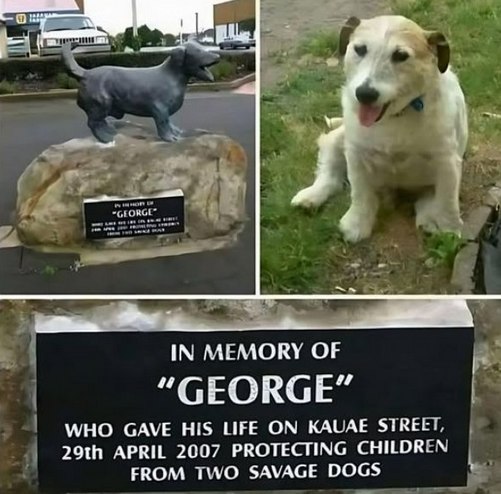

The Chinese earthquake that killed more than 12,000 people was predicted by a mass migration of frogs. Animals tend to seek safety long before the human knows what's coming. When the humans were still living amidst nature, it was easier for them to recognize natures signs. Nowadays, when most people are forced to live in boxes of concrete, they have lost every contact they use to have with nature, and its animals.
Job 12:7–10 "But ask the animals, and they will teach you, or the birds
in the sky, and they will tell you; or speak to the earth, and it will
teach you, or let the fish in the sea inform you."
Check out Plant Based Papi from Oregon, Sophia, the Gentle Chef or Rainbow Nourishments
God needs an army, not an audience
From their wonderful website: The Freedom Farm Sanctuary was created out of a vision shared by hundreds of thousands in Israel, who aspire to make a significant change in the attitude of human beings towards other earthly creations, who dream that one day we will be able to view animals as creatures entitled to lives of freedom, with whom we can live side by side harmoniously without hurting, abusing or exploiting them, and without taking their flesh, their liberty, and their soul. Also check out Edgar's mission!
Ecclesiastes 3:17-20 "As for humans, God tests them so that they may see that they are like the animals. Surely, the fate of humans is like that of the animals; the same fate awaits them both: As one dies, so dies the other. All have the same breath; humans have no advantage over animals."
Emma the Hero Mom Who Carried Her Children Through Fire
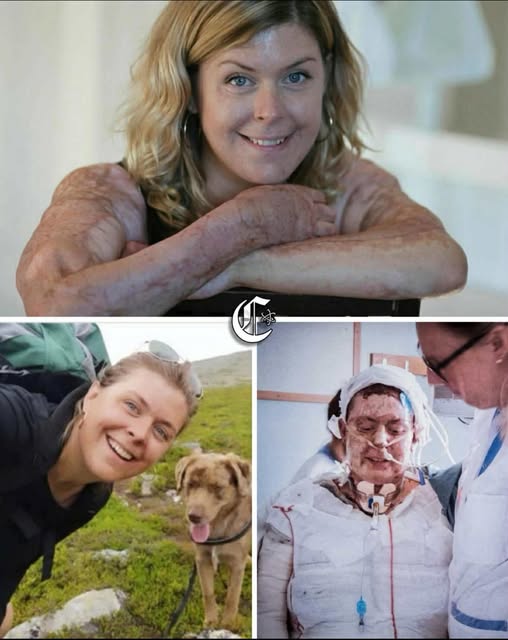
A mother from Sweden jumped into a living hell of flames to save her six children—and survived with 93% of her body burned.Emma Schols, 31, woke up in the middle of the night to the smell of smoke in her home in Edsbyn, Sweden. Without waiting for help, she ran barefoot through fire up the stairs, entered every room, and carried her children out one by one—even jumping from a second-story window with her youngest.When the stairs collapsed, she went back into the flames four more times, facing fire and toxic smoke. All of her children made it out unharmed.Emma fell into a coma for over two months and underwent more than 20 surgeries. Yet, when she woke up, her first question was:"Are my children okay?"Her bravery earned her the title of Heroine of the Year in Sweden in 2020. But for many, it stands for something even deeper: the unbreakable strength of a mother's love—willing to face death itself to protect what she loves most.
Scarlett the Cat Who Walked Through Fire for Her Kittens
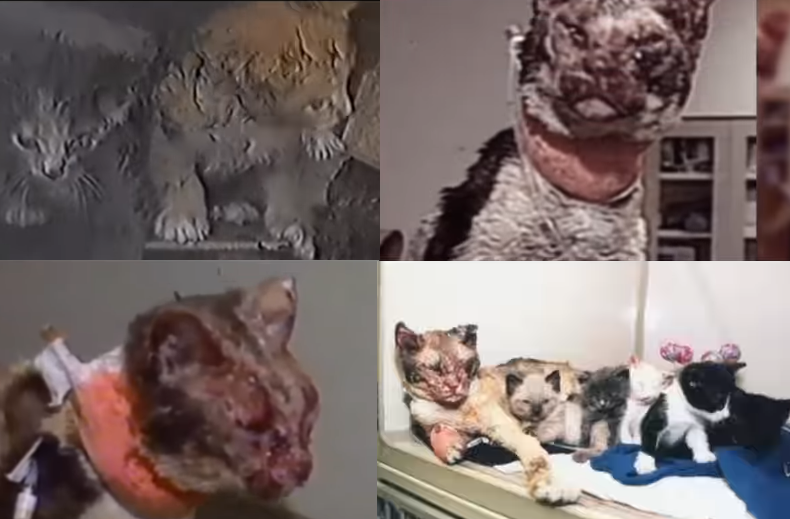
Scarlett (June or July 1995 – October 11, 2008) was a former stray cat from Brooklyn, New York, whose efforts to save her kittens from a fire attracted worldwide media attention, and has been described in several non-fiction books. If the kittens were her first litter, Scarlett was probably about nine months old.
On March 30, 1996, Scarlett and her five kittens were in an abandoned garage allegedly used as a crack house in Brooklyn when a fire started from undetermined causes. The New York City Fire Department responded to a call about the fire and quickly extinguished it. When the fire was under control, one of the firefighters on the scene, David Giannelli, noticed Scarlett carrying her kittens away from the garage one by one. Scarlett herself had been severely burned in the process of pulling her kittens from the fire.
Her eyes were blistered shut, her ears and paws burned, and her coat highly singed. The majority of her facial hair had been burnt away. After saving the kittens she was seen to touch each of her kittens with her nose to ensure they were all there, as the blisters on her eyes kept her from being able to see them, and then she collapsed unconscious. Gianelli took the intact family to a veterinary clinic at the North Shore Animal League in Port Washington, New York where Scarlett and her kittens were treated. The weakest of the kittens, a white-coated, died of a virus a month after the fire. However, after three months of treatment and recovery, Scarlett and her surviving kittens were well enough to be adopted.
The problem is that humans have victimized animals to such a degree that they aren't even considered victims. They're not even considered at all. They're nothing. They don't count; they have no value; they're commodities - like TVs and cell phones. We've actually turned animals into inanimate objects - sandwiches and shoes." ~ Gary Yourofsky
The Fight Against Bullfighting
In many countries, bullfighting is still defended as cultural heritage: with its colorful costumes, the tension of the arena, the marching bands. But behind this romantic image lies violence, suffering, and the death of animals that stand no chance. Public opinion is shifting. Activists like Peter Janssen, longtime leader of the Vegan Strike Group, play a significant role in this change.
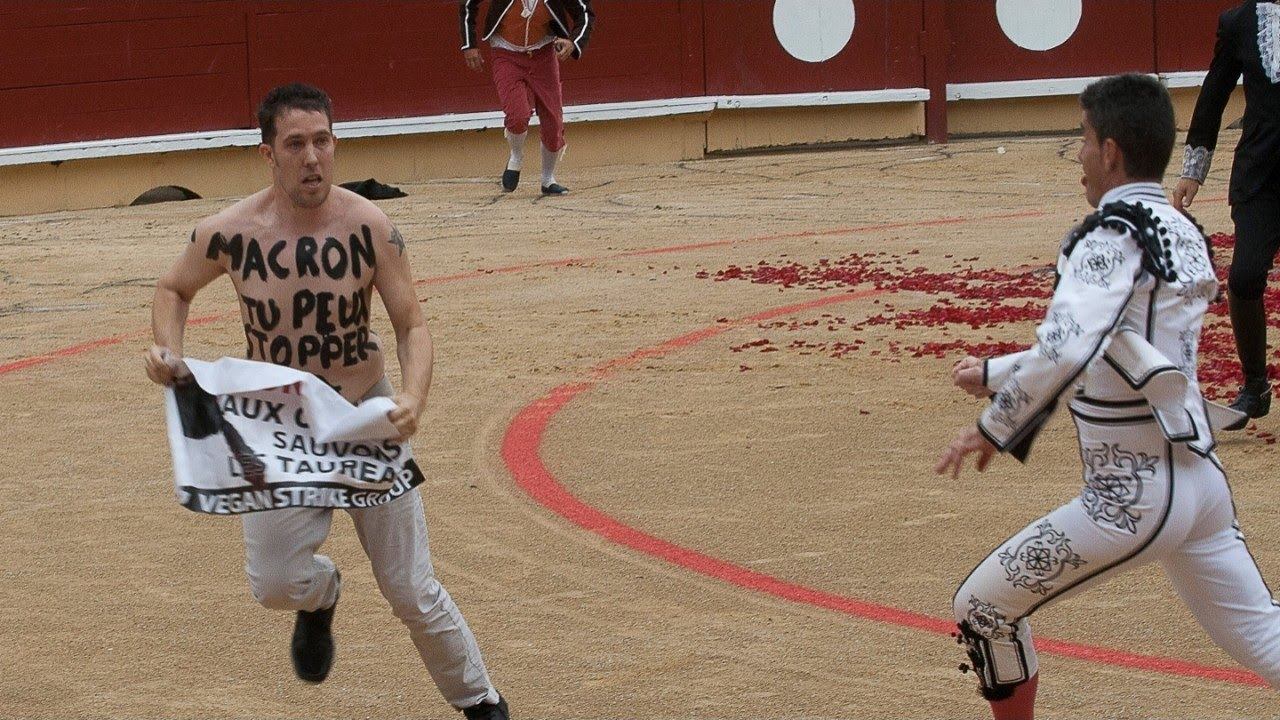
Since 2013, Janssen claims to have protested more than 80 times in bullfighting arenas across Spain, France, and Portugal. His protests are striking, deliberately provocative, and almost always aimed at revealing the truth: what happens in the arena is not art, but abuse. During a protest in Lisbon, he was severely assaulted by bystanders and staff. The footage went viral, along with the message: animals do not belong in an arena.
Public opinion is slowly but surely changing. According to a survey by Fundación BBVA in Spain, 77 percent of the population now disapproves of bullfighting. Only a small minority actively attends the events. Over the past ten years, the number of bulls killed in Spanish arenas has dropped from around 16,000 to 7,000. The number of official fights has also significantly decreased. What was once a national pride is increasingly seen as a relic of a violent past.
Yet it is not only public opinion that is changing. Progress is also being made legally and politically.
In Mexico City, a decision was made in 2025 to ban traditional, bloody bullfights. Instead, only "bloodless" versions are now permitted, with protected horns and no lethal outcome. Steps have also been taken in Portugal: in cities like Póvoa de Varzim, the local arena was closed and converted into a different public space. In France, animal rights organizations succeeded in taking legal action against recognizing bullfighting as cultural heritage, leading to bans in some places due to a lack of "local tradition."
Activism plays a crucial role in this progress. Groups such as AnimaNaturalis, CAS International, and PETA have campaigned for years through demonstrations, legal pressure, and media actions. In Madrid, for example, activists covered themselves in fake blood on the steps of the famous Las Ventas arena. The image went viral worldwide, along with the message: this is not culture, this is torture.
It is striking how often the argument of "tradition" is used to defend animal cruelty, as if something done for a long time is automatically justified. But slavery, women's oppression, and child labor were once also traditions. Today, we look back on them with horror. It is only a matter of time before the same happens with the public killing of animals for entertainment.
The dedication of activists like Peter Janssen and his team is not without risk. But it pays off. Thanks to their persistence—on the streets, in arenas, and in court—the end of bullfighting is drawing ever closer. They show that change begins with people who refuse to look away.
Cruel Barbaric Traditions
Every year on the Faroe Islands, hundreds of dolphins and whales are killed during the traditional grindadráp. This centuries-old practice causes widespread animal suffering but is defended by the local population as cultural heritage.
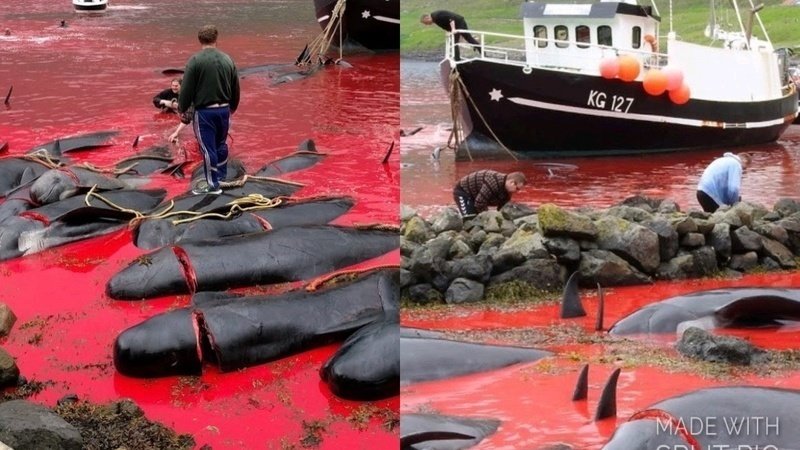
In Spain, the annual El Carpio de Tajo festival takes place, where live geese are hung and decapitated by horse riders to honor the patron saint Santiago. Although animal activists have succeeded in ensuring the animals are now killed beforehand, it remains a violent tradition that upholds the killing of animals as a festive act. This kind of cruelty is often presented as part of Christianity, but it has nothing to do with true Christian values,
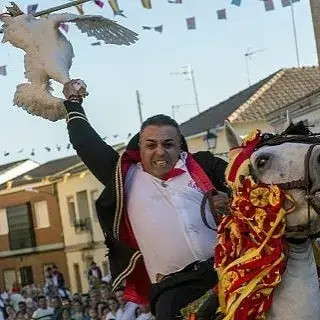
the values of compassion and respect; these are old cultural practices that find no justification in faith. These traditions illustrate how some communities place tradition and cultural customs above animal welfare and compassion.
God Sees How We Treat His Creatures

God notices how people treat the animals in their care, and he wants
them to choose kindness, according to a story from Numbers 22 in which a
donkey spoke audibly to her master after he mistreated her. A sorcerer
named Balaam and his donkey encountered the Angel of the Lord while
traveling, and what happened showed the importance of treating God's
creatures well.
Balaam set off on a journey to do some sorcery work for Balak, the king of ancient Moab, in exchange for a large sum of money. Even though God had sent a message in a dream not to do the work - which involved spiritually cursing the Israelite people whom God had blessed - Baalam let greed take over in his soul and chose to take on the Moabite assignment despite God's warning. God was angry that Baalam was motivated by greed rather than faithfulness.
As Balaam was riding on his donkey on the way to do the work, God himself showed up in angelic form as the Angel of the Lord. Numbers 22:23 describes what happened next: "When the donkey saw the angel of the Lord standing in the road with a drawn sword in his hand, it turned off the road into a field. Balaam beat it to get it back on the road."
Balaam went on to beat his donkey twice more as the donkey moved out of Angel of Lord's way. Each time the donkey moved abruptly, Balaam got upset by the sudden movement and decided to punish his animal. The donkey could see the Angel of the Lord, but Balaam couldn't. Ironically, even though Balaam was a famous sorcerer who was known for his clairvoyant abilities, he couldn't see God appearing as an angel - but one of God's creatures could. The donkey's soul was in a more pure state than Balaam's soul was.
Matthew 5:8 Blessed are the pure in heart: for they shall see God.
Purity makes it easier to perceive angels because it opens up spiritual perception in the presence of holiness. Then,
miraculously, God made it possible for the donkey to speak to Balaam in
an audible voice to get his attention. "Then the LORD opened the
donkey's mouth, and it said to Balaam, 'What have I done to you to make
you beat me these three times?'" verse 28 says.

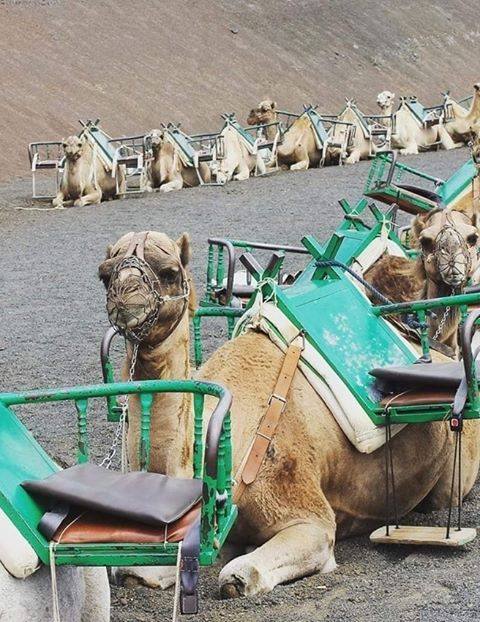
Party for the Animals – A Pioneer in the Fight Against Animal Suffering
In a world where economic growth often outweighs compassion, there is one political party that gives a voice to the voiceless: the Party for the Animals (PvdD) from the Netherlands. Founded in 2002, it was the first political party in the world to focus explicitly on animal rights, the environment, and sustainability — making history in the process.
The PvdD was co-founded by Marianne Thieme, who served as the party's figurehead for many years. From her Christian-inspired worldview, Thieme emphasized in numerous interviews the moral responsibility of humans to care for creation - including the animals. She viewed the exploitation of animals not just as an ecological issue, but as a deeply moral one.
"Compassion is not a luxury, but a necessity in politics."
- Marianne Thieme
"I see animals as fellow creatures. As a Christian, I believe we do not own the Earth, but have received it in stewardship — to take good care of it." - Marianne Thieme
The Party for the Animals started out small, but grew into a meaningful political force — both nationally and internationally.
Some major milestones include:
2006: The PvdD wins two seats in the Dutch House of Representatives — a historic first for an animal rights party.
International inspiration: The PvdD has inspired similar parties across the globe, with sister parties now active in countries such as Germany, Portugal, and the UK.
Climate and environment: Beyond animal rights, the party also addresses broader themes like climate change, biodiversity, and the transition to a sustainable economy.
- Animal welfare on the political agenda: The party has consistently pushed animal welfare into mainstream politics. Issues such as the ban on wild animals in circuses, tackling factory farming, and promoting plant-based food have all been discussed — and influenced — thanks in part to the PvdD
The Party for the Animals is not a traditional interest group, but an ethical movement advocating for a fundamental shift in how we relate to animals, nature, and one another. It represents not only the interests of humans, but also those of animals, future generations, and the planet as a whole.
Note: After the departure of Marianne Thieme, the Party for the Animals has increasingly turned its attention to human issues instead of focusing primarily on animal rights. This has led to several members leaving the party. A recent example is the party congress where the Russian feminist punk group Pussy Riot performed. This group became known for their protest action in a cathedral in Moscow against President Putin, after which several members spent two years in a labor camp. The PvdD enthusiastically announced their performance, emphasizing their commitment to freedom, LGBTQI+ and women's rights. During the congress they also held a conversation with party leader Esther Ouwehand.
At the same time, the party announced that it wanted to increase defense spending because of the war in Ukraine – a clear shift for a party that once began as pacifist. These developments have led to dissatisfaction and even a split: the pacifist animal party Peace for Animals.
This party once again focuses solely on animal welfare and rejects military spending (we will protect ourselves with flowers and stardust...), and – like many other parties – seems naïve in its stance toward mass migration and its consequences for Europe. As long as they confine themselves to animal issues there is no problem, but once Peace for Animals starts involving itself in matters in which it has no expertise, the same fate threatens as with the PvdD: loss of focus, disappointed members, and ultimately no future.
Farmer–Citizen Movement (BBB): Farmers' party with animal-unfriendly policies and a violent support base
The BBB represents in the Netherlands the opposite of the Party for the Animals (PvdD). Whereas the PvdD focuses on animal welfare, climate, and environmental protection, the BBB emphasizes farmers' interests and the preservation of the countryside, often without attention to animal welfare and with close ties to groups that carry out aggressive protest actions.
The Farmer–Citizen Movement (BBB) was founded in 2019 and presents itself as the political voice of farmers and citizens. Although the party portrays itself as a defender of rural areas, its policies show that animal welfare is not a priority. For example, in its election program the BBB advocates "reducing or excluding" wild animals to protect farm animals from diseases, without consideration for the welfare of the animals themselves.
In addition, the party has opposed proposals for stricter animal welfare legislation and has contributed to the weakening of the Animal Act.
The BBB maintains close ties with Farmers Defence Force (FDF), an activist group known for aggressive and sometimes violent protests. This relationship casts a shadow over the party's image and raises questions for voters who value peaceful protest.
Violent actions and intimidation by BBB supporters and FDF:
-
Destruction of police cars and resistance against officers, including pushing aside vehicles to give tractors access to the home of Minister Van der Wal.
-
Farmers hitting police cars and vans with hammers and iron bars (Harskamp, June 2022).
-
Attempted manslaughter during protests in the east of the Netherlands and in Heerenveen, with multiple arrests (July 2022).
-
Arson along highways and roadside fires, including setting hay bales and other obstacles on fire on the road.
Tractors driving the wrong way and highway blockades that endangered road users.
Threats directed at politicians, such as Minister Van der Wal, and intimidation of citizens who reversed protest actions against BBB/FDF or removed flags.
Threats and intimidation of animal rights activists; according to the election program, the party wants to "impose stricter punishments on animal extremism."
The BBB and its supporters have repeatedly shown that their actions can lead to dangerous situations for police, citizens, and infrastructure. Combined with the lack of focus on animal welfare, this paints a picture of a party that primarily serves farmers' interests and rural preservation, while peaceful protest and animal-friendly policy are subordinated.
Dutch political parties and animal welfare: overview of facts
Christian Union (CU), Carola Schouten: As Minister of Agriculture, Nature and Food Quality and Deputy Prime Minister, she ignored evidence of animal abuse in livestock farming and claimed there was no proof, despite footage that reached international media. Decisions around circus elephant Buba illustrated how animal welfare was subordinated to political interests and personal beliefs.
CDA, Ferdinand Grapperhaus: As Minister of Justice and Security, he called for violence and theft against animal rights activists. He has a background in pig farming, which makes his position on animal welfare issues controversial.
Other parties:
FVD (Baudet): Supports bullfighting and other forms of animal cruelty.
SGP: Policies and religious beliefs lead to little attention to animal welfare.
PVV (Wilders) and JA21: Show support for farmers' interests over animal welfare.

What does it say about a holy place, if it cannot recognize the sacred in the most desperate of creatures?
The Absence of Mercy Is the Presence of Evil
In Veracruz, Mexico, a cow escaped on her way to the slaughterhouse. Driven by sheer instinct and a will to live, she ran through the streets until she reached a church - fittingly named Our Lady of Mercy.
But mercy was nowhere to be found.
She wasn't granted sanctuary. She wasn't seen as a soul seeking refuge — only as property that had strayed.
Despite her desperate plea for life, no one stepped in.
She was taken away. And now, she's gone.
She entered a place built on compassion, and still, no one could see her as worthy of it.

A truck carrying cows to slaughter rolled over. Two animals escaped from the overturned vehicle and made a run for it. One ran for the open doors of a supermarket and was shot dead - allegedly in the meat aisle.
If you were a true carnivore and think it's "natural" to eat animals, then this photo should make you hungry.

Mother Cow With Child Ran For Freedom, Shot Down With 70 Bullets
France, a couple years ago...and instead of being rescued to live in a sanctuary, she was gunned down, with her baby....
70 bullets were shot at her, without mercy..
If honeybees were paid minimum wage for their work, a jar of honey would cost more than $180,000. Honeybees all over the world are dying at alarming rates due to several factors, including an increase of pesticides and parasites, decrease in habitat and lack of proper nutrition. By herself, one honeybee makes only 1/12 of a teaspoon of honey in her entire life! Their rapid decline isn't just an environmental issue - it's a human survival issue. When the bees fall silent, the fields follow.
Animals are not killed with hugs in slaughterhouses
Those who pay, hold the power. Our money is a vote - and animals pay the price.

The very saddest sound in all my memory was burned into my awareness at age five on my uncle's dairy farm in Wisconsin. A cow had given birth to a beautiful male calf. The mother was allowed to nurse her calf but for a single night.
On the second day after birth, my uncle took the calf from the mother and placed him in the veal pen in the barn - only ten yards away, in plain view of the mother.
The mother cow could see her infant, smell him, hear him, but could not touch him, comfort him, or nurse him. The heartrending bellows that she poured fourth, minute after minute, hour after hour, for five long days - were excruciating to listen to.
Since that age, whenever I hear anyone postulate that animals cannot really feel emotions, I need only to replay that tortuous sound in my memory of that mother cow crying her bovine heart out to her infant." Michael Klaper
Humane farming is a myth. From the moment those animals are taken from those trucks and forced through the slaughtering process, it is the most inhumane treatment that I've ever witnessed. ~ Cayce Mell
Confessions of Slaughterhouse Workers - BBC
"We tried to keep them within the rails of the pens, but they were so small and bony that they could easily skip out and trot around, slightly wobbly on their newly born legs. They sniffed us, like puppies, because they were young and curious. Some of the boys and I stroked them, and they suckled our fingers."
"I've taken out my job pressure and frustration on the animals, on my wife, ... and on myself, with heavy drinking." Then it gets a lot worse: "... with an animal who pisses you off, you don't just kill it. You ... blow the windpipe, make it drown in its own blood, split its nose... I would cut its eye out... and this hog would just scream. One time I ... sliced off the end of a hog's nose. The hog went crazy, so I took a handful of salt brine and ground it into his nose. Now that hog really went nuts..."
"The chickens hang there and look at you while they are bleeding. They try to hide their head from you by sticking it under the wing of the chicken next to them on the slaughter line. You can tell by them looking at you, they're scared to death." ~ Virgil Butler, former Tyson chicken slaughterhouse worker
Unborn and Unprotected: The Fate of Fetal Calves
According to the British Cattle Veterinary Association, 150,000 pregnant cows are sent to slaughter each year.
At least 40,000 of these cows are in the last stages of their pregnancy and are bearing calves who may be capable of independent life. In addition to the trauma of still being alive inside their mothers during the latter's death, fetal calves may also be cut from their mother's womb while still alive so that their blood can be drained for use in science, without anesthesia, (fetal bovine serum or fetal calf serum). In addition the calf is used for 'high quality' leather. Source: British Cattle Veterinary Association
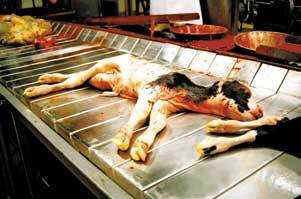
More than a quarter of cows suffer from lameness due to animal abuse
Netherlands, 2025 (source) Shocking figures from recent scientific research show that around 28 percent of Dutch dairy cows are lame. In one-third of these animals, the complaints are so severe that they try to relieve an entire leg while standing or walking. This painful reality raises questions about the ethics of modern dairy farming.
Concrete barn floors: the culprit
Research from Utrecht University, Wageningen University, and Cornell University points to a clear cause: hard concrete barn floors. Cows are naturally used to walking on soft surfaces, such as grass or forest ground. Their legs are simply not made for life on concrete, leading to chronic pain and lameness.
Economy over animal welfare
Despite subsidies for grazing, the number of cows permanently kept indoors is increasing. Larger dairy farms increasingly prioritize efficient production over animal welfare, keeping cows indoors year-round.
This trend is reinforced by investments in barns that, while reducing nitrogen emissions, paradoxically lead to more hoof problems.
Solutions are known but expensive
Research shows that lameness drastically decreases when cows have access to pastures or soft barn floors with bedding. Some farms report almost no lameness, while others have peaks of up to 60 percent. This proves that animal-friendly approaches are possible, but the reality is that new barn facilities are costly.
Wakker Dier, co-financier of the research, emphasizes that the current situation is unacceptable. The question is how long we will continue to tolerate this form of structural animal abuse for cheap milk.
"Solutions are known but expensive"—we also see this with barn fires, in which millions of animals die annually and a smoke detector is not required. After all, under the law, animals are still considered 'goods.'
Who Is Calf 269 and What Is 269 Life?
Calf 269 was a young bull, born on a dairy farm near Tel Aviv, Israel, and marked with the number 269. In June 2013, just before he was scheduled to be slaughtered, he was rescued by anonymous activists. His rescue sparked the creation of the activist movement 269 Life.
On October 2nd, 2012 - World Farm Animals Day - activists in Tel Aviv burned the number 269 into their skin in Rabin Square. This act symbolized their message: no animal should die in anonymity. Every sentient being deserves to be recognized as an individual. The powerful images went viral, and soon, people around the world began tattooing or branding the number '269' on their own bodies in solidarity with animals in the farming industry.
What began with the rescue of a single calf has since grown into a global movement opposing animal exploitation in all its forms. Members of the movement use "269" as a visual symbol of awareness—often inked or burned into their skin—to confront the mass suffering and erasure of identity experienced by billions of farmed animals (abc.net.au).
The stories of 269 and his companions, like Luna and Diana-rescued cows now living in safety and health-remind us that every animal is someone, not something. Through their survival, we are forced to confront a deeper ethical question: how long can we remain silent while billions live and die nameless in the shadows of industry?
Cow 269 passed away in 2025, listen to Gary Yourofsky here
You don't need meat. You need compassion.
You don't need meat to build muscle, run faster, or lift heavier. More
and more elite athletes - from runners and cyclists to bodybuilders and
Olympians - are proving that a plant-based diet can fuel peak performance.
💪 Iron? It's found in abundance in plant foods like lentils, tofu, spinach, beans, pumpkin seeds, and quinoa. Your body can absorb it just fine - especially when combined with vitamin C (like citrus or bell peppers).
🥬 Protein? Every plant contains protein. Athletes thrive on beans, lentils, nuts, whole grains, and soy — without the cholesterol or inflammation that often comes with animal products.
💊 B12? Yes, vegans supplement it — not because plants lack it, but because modern hygiene removes soil bacteria where B12 naturally comes from. Animals get it from supplements too, or from eating unwashed soil — vegans just skip the middleman.
👉 You don't need to eat an animal who ate plants — just go straight to the source.
Are we so numb that even tears leave us untouched?
For decades, researchers and wildlife guides have observed one of the most powerful signs of animal grief among African and Asian elephants. When an elephant dies, others in the herd often stop, gather, and gently touch the body or bones with their trunks. Sometimes they stand in silence for hours. What is even more remarkable is that years later, elephants have been documented changing their migration routes to revisit the exact site where a family member died.This behavior has been witnessed in Kenya's Amboseli National Park, Botswana's Chobe National Park, and across reserves in India. Scientists have described elephants approaching the skeletal remains of relatives, lifting bones, and stroking tusks, as though recognizing the individual who once lived. Unlike other animals, their mourning rituals extend beyond the immediate death, they continue to honor the memory long after.What does it mean? To many, it suggests that elephants carry with them a sense of memory, grief, and family ties that rival our own. They do not just forget and move on, they remember, they revisit, they mourn.
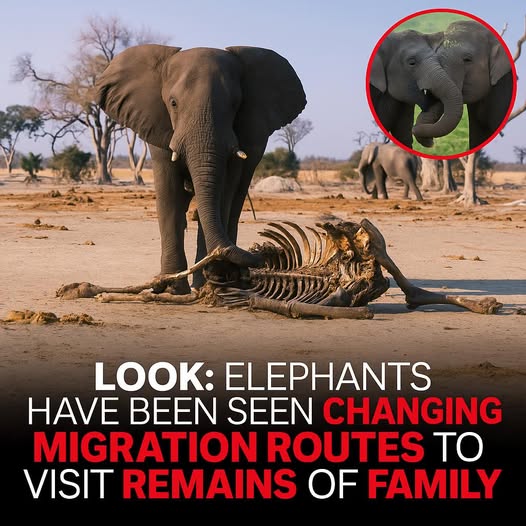


This event, documented by marine researchers, became known worldwide as "The Orca Mother's Tour of Grief."Day after day, she refused to let go.
She balanced the calf on her head, nudged it with her rostrum, and dove beneath it to push it back to the surface. The calf's body grew heavier, decayed, but still she carried it — through storms, currents, and endless waves.Why would she do this? It wasn't instinct for survival. It wasn't training or habit. It was something deeper — love, grief, and the refusal to accept absence. Orcas, like humans, form profound emotional bonds. Families stay together for life. They share food, protect one another, and raise calves collectively. And when one life is lost, the whole pod feels it.We humans often think mourning belongs only to us. We write obituaries, hold funerals, and light candles.
Yet in the ocean, this mother showed us that grief needs no rituals. Her act was a vigil, a testimony of love carried across salt and time.Her journey reminds us of something universal: the heart is not bound by species. Love does not end at death. Grief is the proof of a bond that was real, and still is.
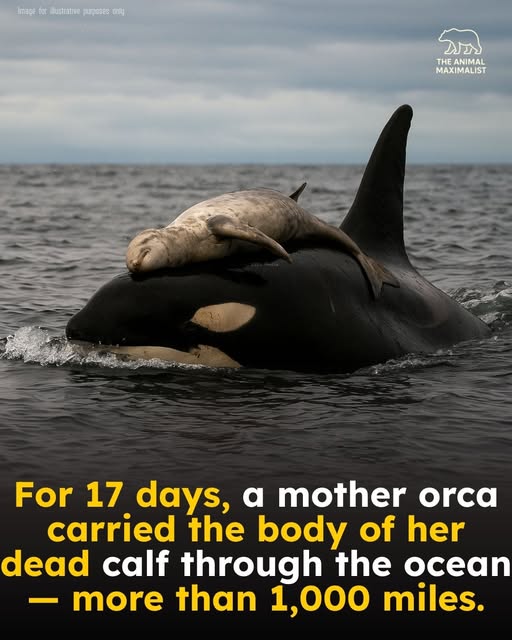
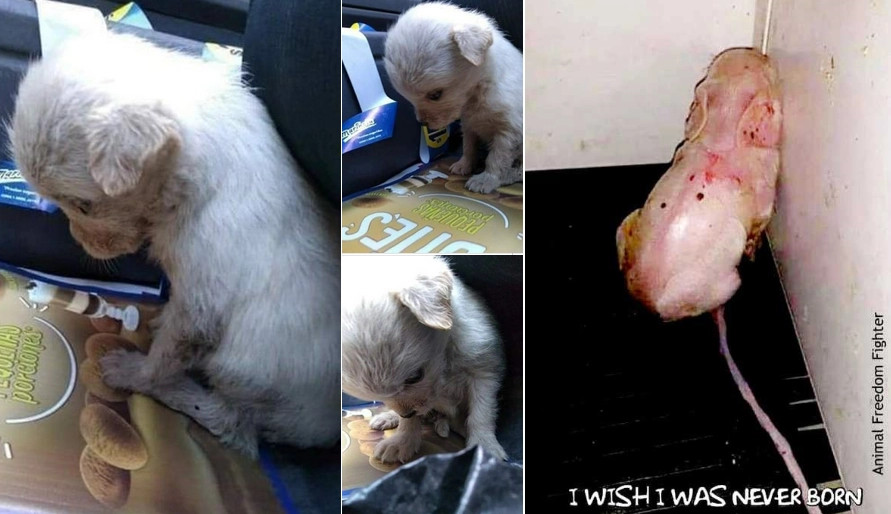
The puppy in the picture was thrown into a dumpster, found in a tightly knotted bag. The little piglet had just been born, only to see her mother unable to move because of life in a factory farm. Children know. Animals know.
Imagine just being born and already aware that you were born to be killed.
We Say We Love Animals — But Our Actions Say Something Else
After the COVID lockdowns, many people struggled with being confined. The moment restrictions lifted, they rushed to zoos—to watch animals still living in captivity.
They couldn't stand being locked up themselves, yet found entertainment in watching other beings who never get to leave.
Or take this: someone lovingly rescues a baby bird that's fallen from its nest, feeling proud to have helped an innocent animal. Later that day, they put a chicken in the oven for dinner—without a second thought.
What's going on here? This is called cognitive dissonance - a psychological tension that arises when our actions don't match our values. Instead of changing our behavior, we often twist reality to feel better about ourselves. But deep down, something doesn't sit right. That discomfort? It's your conscience asking you to align your actions with your values.

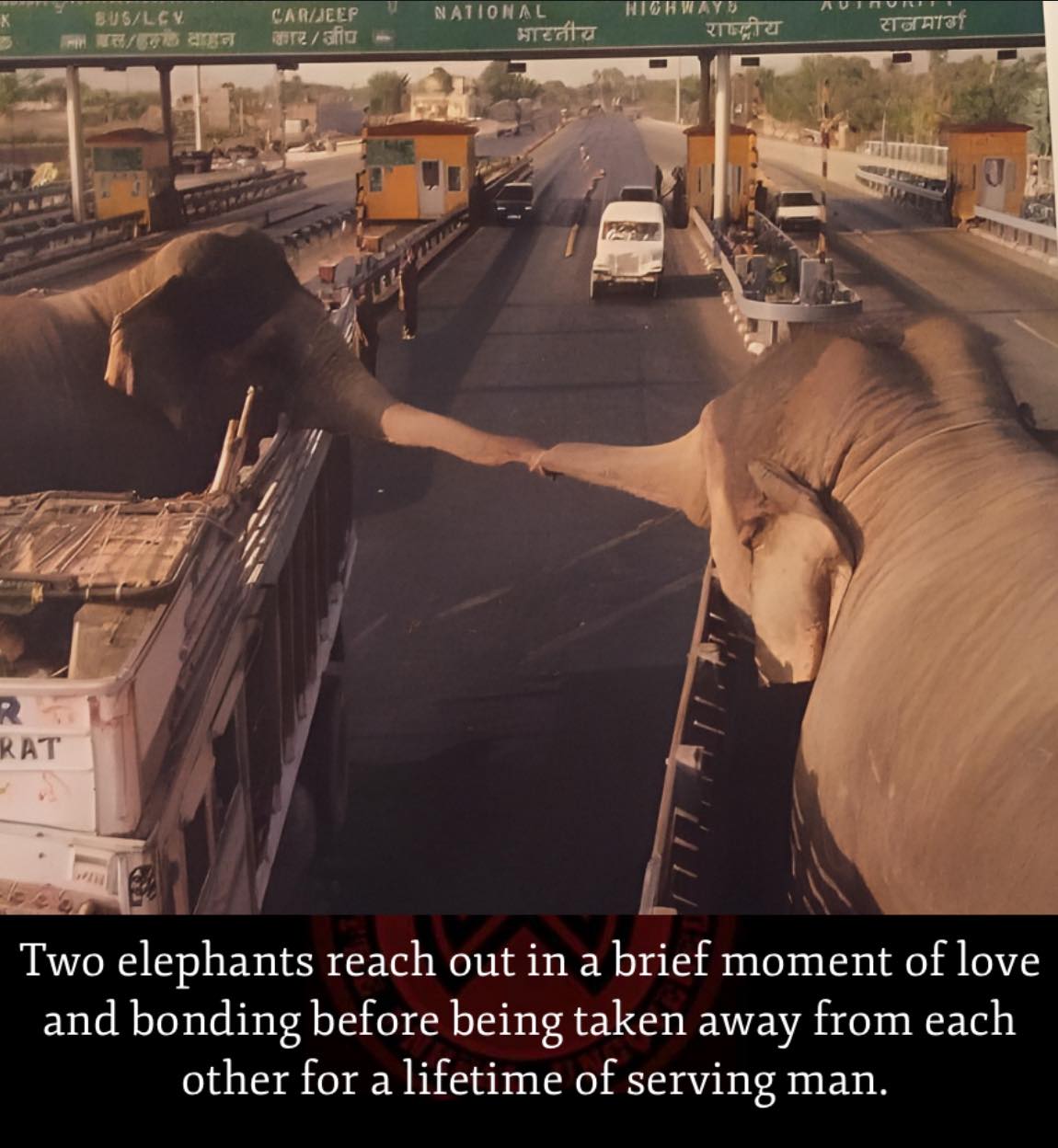
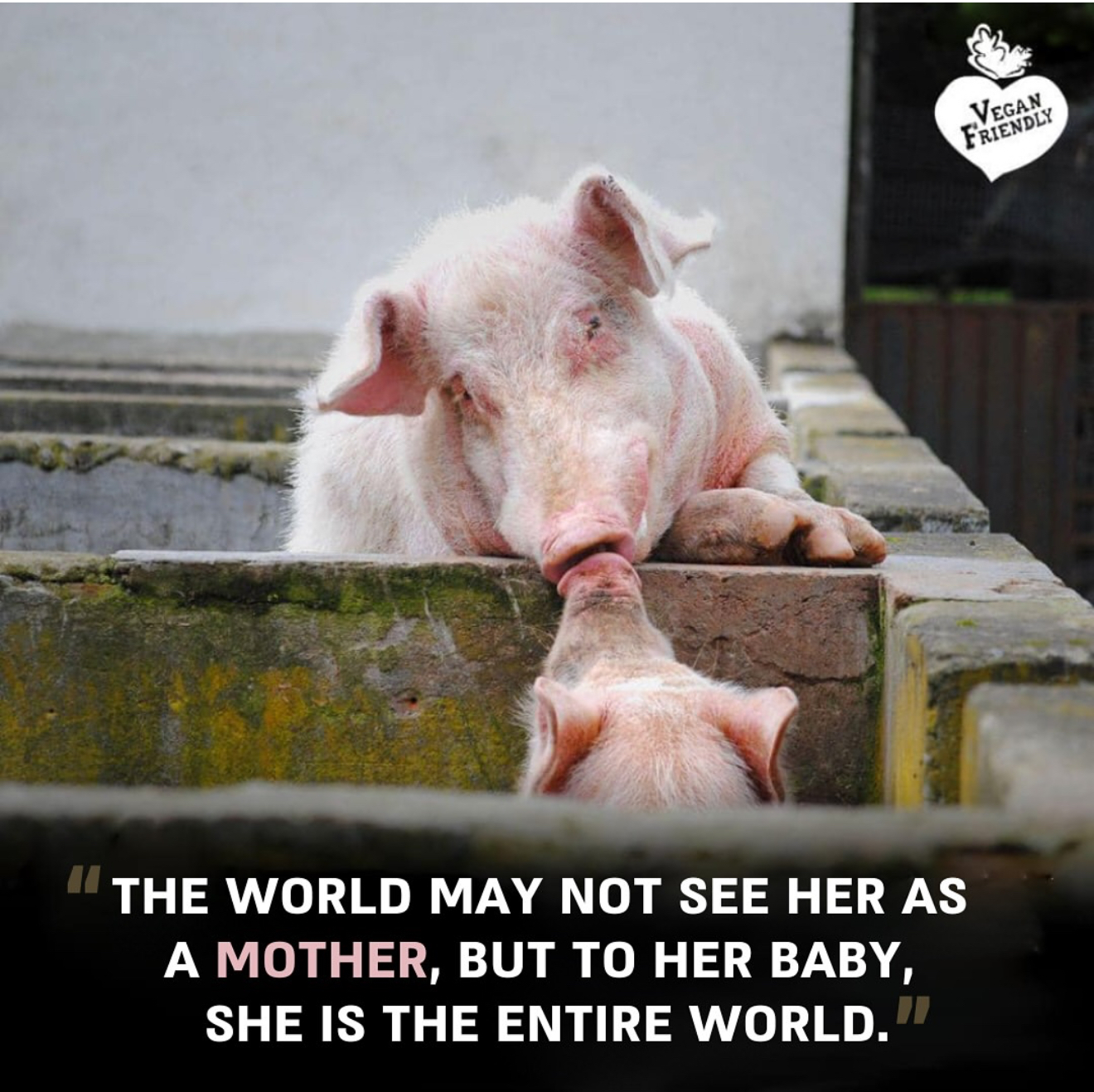
Parents love taking their children to petting zoos - especially around Easter, to see the newborn lambs. They smile, take photos, stroke the soft wool… But they don't tell their children the truth: that many of these lambs will soon be slaughtered. Why not take them to the slaughterhouse too? Why only show them the beginning of a life they won't let live?
This is not teaching love for animals — this is teaching selective affection wrapped in denial.
We hide the violence because we know, deep down, children would be horrified. And maybe that tells us everything we need to know.
Animals Don't Belong in Zoos - Only Sanctuaries Deserve to Exist
It's 2025. We know more than ever about animal welfare, intelligence, and emotions. And yet we continue to lock wild animals in cages and concrete enclosures – for our entertainment. The price they pay is painfully clear in recent news stories.
In Leipzig, three newborn Amur tiger cubs were euthanised. Their mother, tigress Juschka, turned away from her first litter just hours after birth. The zoo decided to put them down "to prevent suffering" – hand-rearing such animals is considered undesirable. For the management, perhaps routine; for the public, shocking.
And Leipzig is not alone. In July, Nuremberg Zoo killed twelve healthy baboons due to lack of space. Their bodies were fed to predators, as if they were surplus stock in a pantry. In Denmark, Aalborg Zoo asked the public to donate unwanted pets – rabbits, guinea pigs – as feed. Healthy animals, sacrificed to keep the system running.
These are not isolated incidents. They are symptoms of an industry that sustains itself through breeding, culling, and killing, all under the facade of education and conservation. But let's be honest: when animal lives end up in a feed bucket or a freezer, there is nothing educational or protective about it.
Alternatives do exist. Sanctuaries and rescue centres offer a safe, permanent home to animals that cannot return to the wild. No shows. No breeding programmes. No slaughter "to keep the population healthy." Only protection, peace, and respect.
The question is not whether zoos should change. The question is why we accept them at all. Every year, healthy animals die behind closed gates – because there's no space, because their genes don't "fit," because the public is tired of them.
Animals deserve better. Not tomorrow. Not in some distant future. Now. It's time to close zoos and invest our resources in genuine rescue and protection.
If you've ever seen a polar bear swimming in circles for hours, a tiger pacing endlessly, or an elephant swaying back and forth with a blank stare, you've witnessed zoochosis - a mental illness caused by captivity.
Zoochosis is a form of psychosis in captive animals, shown by repetitive, purposeless behaviors like pacing, rocking, or self-harm. These behaviors never appear in wild animals and indicate deep mental suffering. Animals evolved to roam freely, socialize, and live rich sensory lives. Captivity denies them this, leading to severe stress and physical brain changes.
Many animals in zoos and captivity worldwide suffer from zoochosis — a clear sign that confinement harms their well-being. The solution? True freedom. Animals deserve to live without cages, just like us.
You're Eating Babies
Lamb isn't just a word for meat — it means baby sheep. Most lambs are slaughtered between 6 and 8 weeks old, long before they've had a chance to grow, play, or bond with their mothers.
The same goes for veal — the flesh of baby calves, often taken from their mothers within days of birth. Their meat is pale and tender because they are still infants.
These animals are not "products" — they are newborns, full of life and trust. Think about what that really means the next time you see "lamb chops" or "veal cutlet" on a menu. Behind the words is a life that barely began.
Whales, "compassionate amazing Buddhist warriors"
The real life Jonah and the whale - 2019 Rainer Schimpf is an experienced wildlife photographer and conservationist who was documenting a 'feeding frenzy' off the coast of South Africa when a whale scooped him up while taking a mouthful of sardines. (source)
Fun Fact: people like Jonah or Cousteau are called aquanauts. An aquanaut is any person who remains underwater, breathing at the ambient pressure for long enough for the concentration of the inert components of the breathing gas dissolved in the body tissues to reach equilibrium, in a state known as saturation.

The glory of nature provides evidence that God exists - Jacques Cousteau, French inventor of open circuit scuba, pioneer diver, author, film-maker and marine researcher
In 2012, during a cold-water diving competition at the Polar Land aquarium in Harbin, China, a beluga whale named Mila saved a diver who had cramped up and begun sinking. Sensing the diver was in distress, the whale gently pushed her to the surface with its nose, preventing a potential drowning. (source)
Whales helping other animals: (source) When the killer whales moved in closer, the humpback arched its chest, lifting the seal out of the water. And when the seal started slipping off, the humpback, according to Pitman, "gave the seal a gentle nudge with its flipper, back to the middle of its chest. Moments later, the seal scrambled off and swam to the safety of a nearby ice floe."
Whales helping humans: (source) Incredible footage captures moment giant whale saves human from shark
Nigerian sailor 'a phenomenon' for surviving in air pocket for 3 days
12 jun. 2013 - Wearing only his underpants, Okene prayed as water seeped slowly but steadily into a 4ft sq air bubble in the cabin. Harrison Okene remained in bubble within upturned boat at depths experts say would be fatal for even experienced divers (source) Nigerian man who survived three days at bottom of Atlantic Ocean credits God for survival ... the night before, Okene's wife had texted him some Psalms, as the couple is Christian. He recalled those Psalms as he waited patiently 100 feet below the surface. "The Lord sustains my life." As Okene waited, temperatures dropped to freezing and oxygen levels began running low. But he trusted in God. (source)
From Quarks to Quasars
Humpback whales are disrupting orca hunts – seemingly driven by an instinct to protect other animals.
It's one of the ocean's most unexpected mysteries: a seal is being chased by a pod of killer whales… when suddenly, two humpback whales charge in, trumpeting, massive, and seemingly determined to stop the attack.
This is no coincidence. In a study of 115 documented cases, scientists observed humpbacks confronting orcas during hunts – and in nearly 90% of those cases, the humpbacks successfully disrupted the attack. Even more surprising? Many of the animals they protected weren't even their own species.
Seals. Sea lions. Gray whale calves. Even sunfish. The humpbacks would show up, position themselves between predator and prey, use their huge fins to shield the victims, and sometimes physically lift them out of the water.
And then? They simply left. No food. No reward. No clear benefit.
Some scientists believe this behavior stems from a protective instinct – evolved to defend their own young – and is now being applied to any creature in distress. Others suspect it points to a complex form of social awareness or empathy in humpbacks, something we are only beginning to understand.
As one researcher put it: "It's almost as if humpbacks just don't like bullies."
There have even been reports of whales traveling long distances just to intervene. One account described humpbacks swimming for hours to reach an orca attack, only to chase the killers off and then quietly vanish into the depths again.
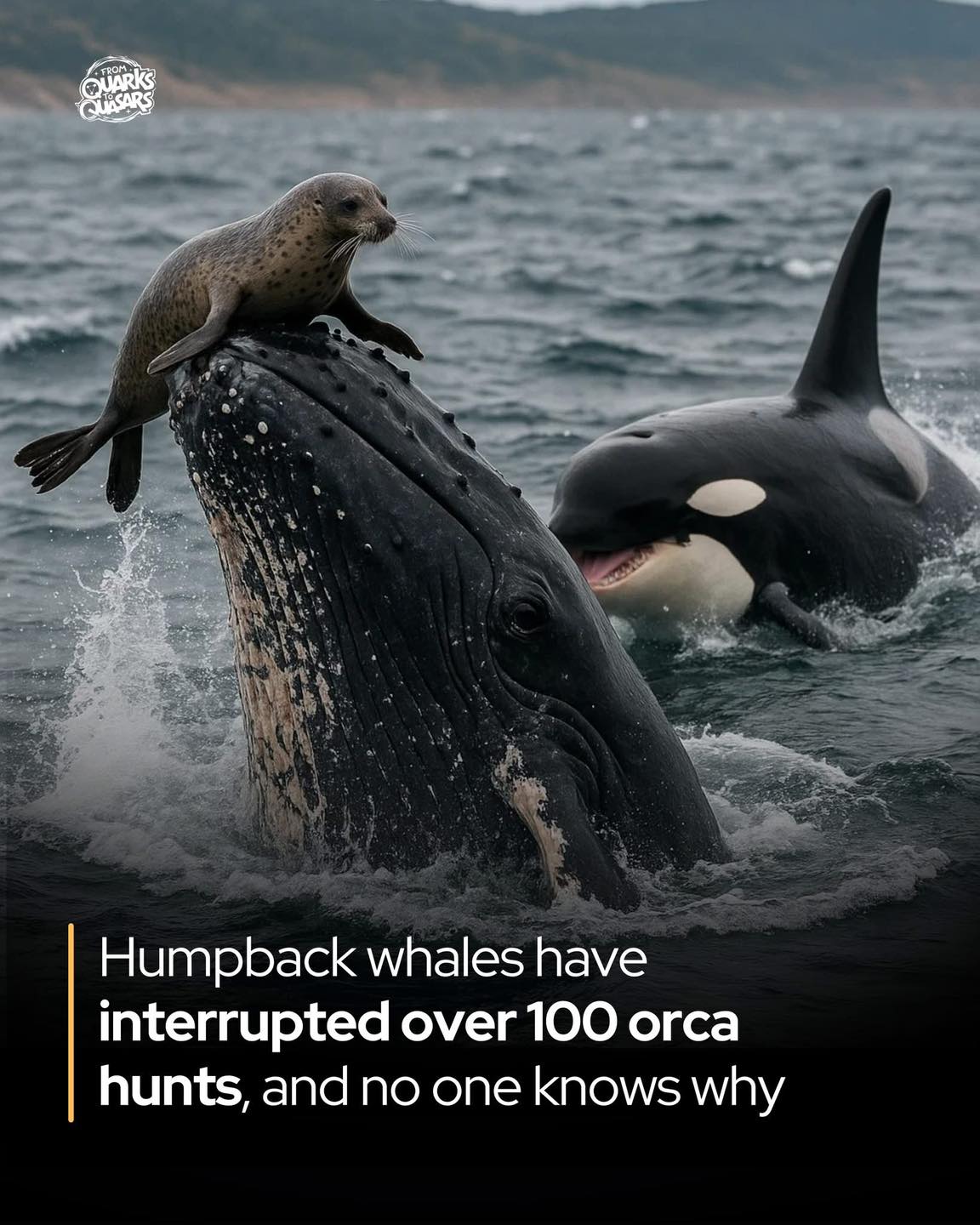
Are these acts of instinct, emotion, or something we don't yet understand?
We don't know. But in a world where survival often means staying silent, the humpback's defiance is loud, deliberate, and extraordinary.
Read more:
Bittel, Jason. "Did Humpbacks Try to Save a Seal from Orcas? See for Yourself." National Geographic, September 7, 2023
Stop Animal Testing - Buy Vegan Only!
Those who pay, hold the power.
Every time we buy animal products or items tested on animals, we fund and authorize that suffering.
Our money is a vote - and animals pay the price.
No less than 87.5% of biomedical research is inefficient and wasteful, says Professor Michael Bracken. Dr. Frances Cheng (source) More than 95 percent of drugs tested successfully on animals end up failing in humans. I dissected and experimented on animals and advocated for their use for more than a decade before I learned, through my own doctoral research, that animal "models" do not reflect human physiology. Critics of animal use are painted as unscientific, as extreme, or as bullies for objecting to even the most abhorrent of experiments. But experimenters' most despicable act is to pretend to be victims when their work is criticized. See full interview at: lockwoodfilm.com/test-subjects
If an animal eats it, it's safe for you? Wrong. Birds and squirrels have the ability to consume certain berries and mushrooms that are deadly to humans due to our biological differences.
The Story of Britches
Britches, a baby macaque born in 1985 at the University of California, Riverside, was torn from his mother at birth. His eyelids were sewn shut, and a sonar device was strapped to his head as part of a cruel sensory-deprivation experiment meant to last three years.
At just 5 weeks old, Britches was rescued by the Animal Liberation Front (ALF) during a raid that freed over 460 animals, including cats, rabbits, rats, and pigeons. The heartbreaking footage of Britches, crying and alone, was shared with PETA, who released it to the public — sparking global outrage.
The public pressure worked: the university permanently ended the eye-sewing experiments, and 8 of the 17 studies disrupted by the raid were never resumed.
While the NIH claimed the lab met "appropriate" standards, the world saw the truth: no experiment justifies that kind of suffering. Britches' story is a powerful reminder: science must never come at the cost of compassion.
"Ask the experimenters why they experiment on animals, and the answer is, 'Because the animals are like us.' Ask the experimenters why it is morally okay to experiment on animals, and the answer is, 'Because the animals are not like us.'"- Charles Magel
Male chicks dropped alive in blenders or thrown away as garbage
In our system a chicken has more space in the oven than it every enjoyed when alive.
Matt 23:37 — "How often I have longed to gather your children together, as a hen gathers her chicks under her wings, but you were not willing."
This tender image of a mother hen gathering her chicks beautifully illustrates care and protection—so much so that Jesus Himself used it to describe His love for people.
It is one of the rare moments where He compares Himself to an animal, highlighting the deep compassion and gentleness embodied by the hen.
And yet, look how we treat these creatures today. Those who pay, hold the power. Our money is a vote - and animals pay the price.

The hens were on their way to slaughterhouse after a short life spent on an egg farm. Their missing feathers are not the result of the fire, but the stress and pecking on the farm. The hen on the right laid her last egg in the rescue car, just before she passed away. The fire was a tragedy, but the bigger tragedy is the egg industry. Please see the suffering of the hens for eggs and consider plant-based alternatives. (source, 2024)
Every day, hundreds of thousands of eggs are 'laid' here—without a single chicken involved
DINTELOORD – When you think of chickens and eggs, Barneveld probably comes to mind. But the country's chicken capital has a formidable competitor: in Dinteloord, Brabant, hundreds of thousands of eggs are 'laid' every day—without a single chicken being involved.
Dénis van Vliet, 22-08-25, source
You won't find an egg vending machine on the grounds of Revyve. Yet the young company produces thousands of kilos of protein daily for snacks, cookies, and sauces. Not from real eggs, but from brewer's yeast—a byproduct of brewing normally used as animal feed.
"We're essentially delivering eggs that don't look like eggs," says CEO Cedric Verstraeten. "For the end user, they can be used almost exactly like regular eggs, with minimal adjustments in the production process."
Revyve was founded at Wageningen University & Research (formerly the Agricultural University), where two biotechnologists discovered that yeast is a surprisingly good alternative to chicken egg protein. In 2019, they launched the company with a mission to produce sustainable food ingredients from natural microorganisms. What began as a laboratory experiment quickly grew into a demonstration factory in Dinteloord, thanks to collaboration with a major brewery and investments from, among others, Cosun (formerly Suikerunie). The factory has been operational since 2024.
But wait a minute. Isn't Cosun undermining its own market? The company is also working on protein alternatives from beans and sugar beets. Verstraeten explains:
"No, not at all—we actually complement each other. Simply put: they provide the 'yolk'—good for binding and creaminess. We provide the 'white,' essential for foam, lightness, and structure."
Anyone entering the factory hall immediately notices the pleasant smell of brewer's yeast. It arrives as a thick, porridge-like mixture. "Essentially, this is where our eggs come from," says Verstraeten, pointing to two enormous tanks.
Inside a cylindrical machine filled with tiny spheres—similar to ball bearings—the egg is effectively 'broken.' The process then separates the 'yolk' from the 'white,' which is subsequently dried. At the end of the production line, a white powder rolls off the belt, closely resembling the protein powder used by athletes.
Although the company has only been running for a year, Revyve already supplies major producers of snacks and sauces. Verstraeten would like to reveal their clients, but cannot. "The buyers don't want to give their competitors an advantage, and I understand that. Egg prices are currently very high due to several factors, including the Russian war against 'egg-country' Ukraine. This is a good and cheaper alternative."
To prove that 'Revyve egg' is on par with regular egg, he lets his guests—a reporter and a photographer—taste a muffin. Normally, twelve muffins would require one to two eggs. The verdict: the treat matches the traditional version in taste and appearance. The muffins are airy, moist, and rich in flavor, without a single drop of animal egg.
Revyve has big plans for the future: the company is considering a larger production facility. "Maybe over there," says Verstraeten, pointing to a patch of grass outside.
Pigs are highly intelligent animals - even smarter than dogs, according to multiple studies.
They can learn their names, solve puzzles, and show emotional complexity. Naturally, pigs are clean, social, and curious beings. But in the meat industry, they are denied every expression of who they are.
They live in barren cells, without stimulation, sunlight, or even something as simple as a toy.
What we see in these photos is not the nature of pigs - it's the result of a system that reduces sentient beings to products. God literally denied taking a wicked city down because of it's animals, and this is how YOU treat His children?
God speaks in Jonah 4:11 And should I not have concern for the great city of Nineveh, in which there are more than a hundred and twenty thousand people who cannot tell their right hand from their left - AND ALSO MANY ANIMALS?" Those who pay, hold the power. Our money is a vote - and animals pay the price.
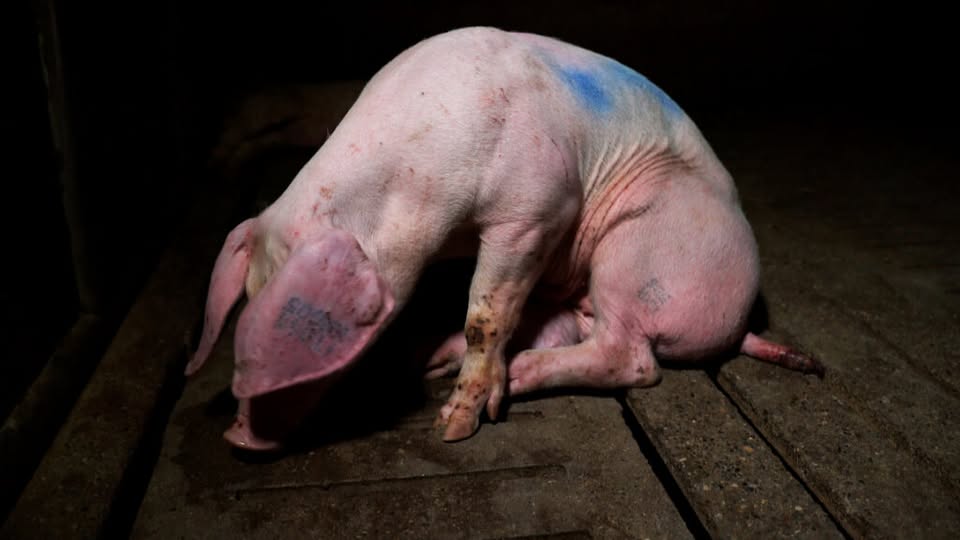
Thousands of people who say they 'love' animals sit down once or twice a day to enjoy the flesh of creatures who have been utterly deprived of everything that could make their lives worth living and who endured the awful suffering and the terror of the abattoirs ~ Jane Goodall
Farmer Defence Force and the barn occupation in Boxtel
In May 2019, 126 animal activists from both the Netherlands and abroad entered a pig barn in Boxtel to expose the appalling conditions inside. At the same time, around 125 others protested outside the barn. Due to rising tensions, partly because of farmers' supporters arriving, the police closed the barn doors—not out of fear that animals would be released, but to prevent a confrontation. Skirmishes occurred, with activists' vehicles being pushed into ditches. After about ten hours, the occupation ended.
Initially, a magistrate imposed fines of 300 euros and a two-week suspended prison sentence on the activists. However, in 2024, the court of appeal in Den Bosch acquitted sixty of the activists. The ruling stated that the barn doors were not forced open, the action was peaceful, and it could be necessary for activists to witness the situation firsthand to expose abuses.
From Action to Organization
The confrontation in Boxtel marked the start of the formation of the group Farmer Defence Force (FDF). Originally an informal WhatsApp and Facebook group, FDF grew into a prominent activist group opposing barn occupations, nitrogen policies, and animal rights activism. FDF booths appeared at national protests, sometimes accompanied by harsh language and intimidation of activists. After the acquittal was announced, leader Mark van den Oever stated that members were armed to prevent future barn occupations. He even distributed signs to place on barns reading: "Under FDF protection — run away if you see this."
The NCTV (Dutch National Coordinator for Counterterrorism and Security) mentioned FDF in its reports due to their increasingly intense rhetoric and actions, which were seen as polarizing. This included intimidation, blockades, the use of fireworks against police, and threats directed at politicians and activists.
In July 2020, a Dutch politician filed a complaint against members of Farmers Defence Force for death threats. Additionally, the organization was reprimanded by the Advertising Code Committee for misleading advertising about farm life. Animal protection group Ongehoord accused FDF chairman Mark van den Oever of animal abuse in his pig barns. Furthermore, in 2020, a 17-year-old boy was arrested for attempted manslaughter following a tractor incident during farmers' protests. There have also been reports of intimidation by FDF members towards citizens and farmers.
Why were the activists protesting?
The Boxtel occupation aimed to reveal the hidden reality inside the barn and to experience the abuses firsthand. For activists, it was crucial to see with their own eyes why the barns were in such poor condition. The acquittal legally sets a precedent for this type of direct protest.
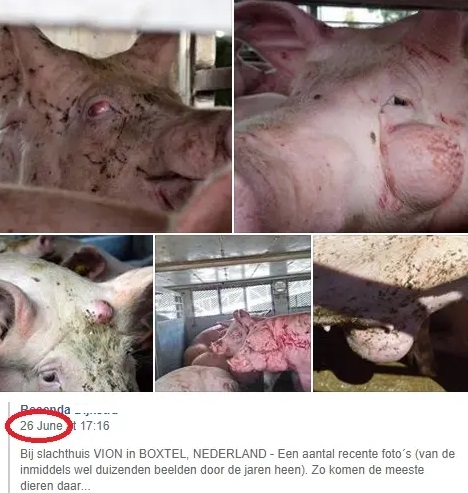
This photo shows pigs (at the VION slaughterhouse in Boxtel) with a visible tumor. Animals with serious health problems are often sent to the slaughterhouse without adequate inspection. Tumors are not always removed, allowing cancer cells to remain in the meat. This raises serious concerns about animal welfare and food safety.
Rise of cruelty-free farmers
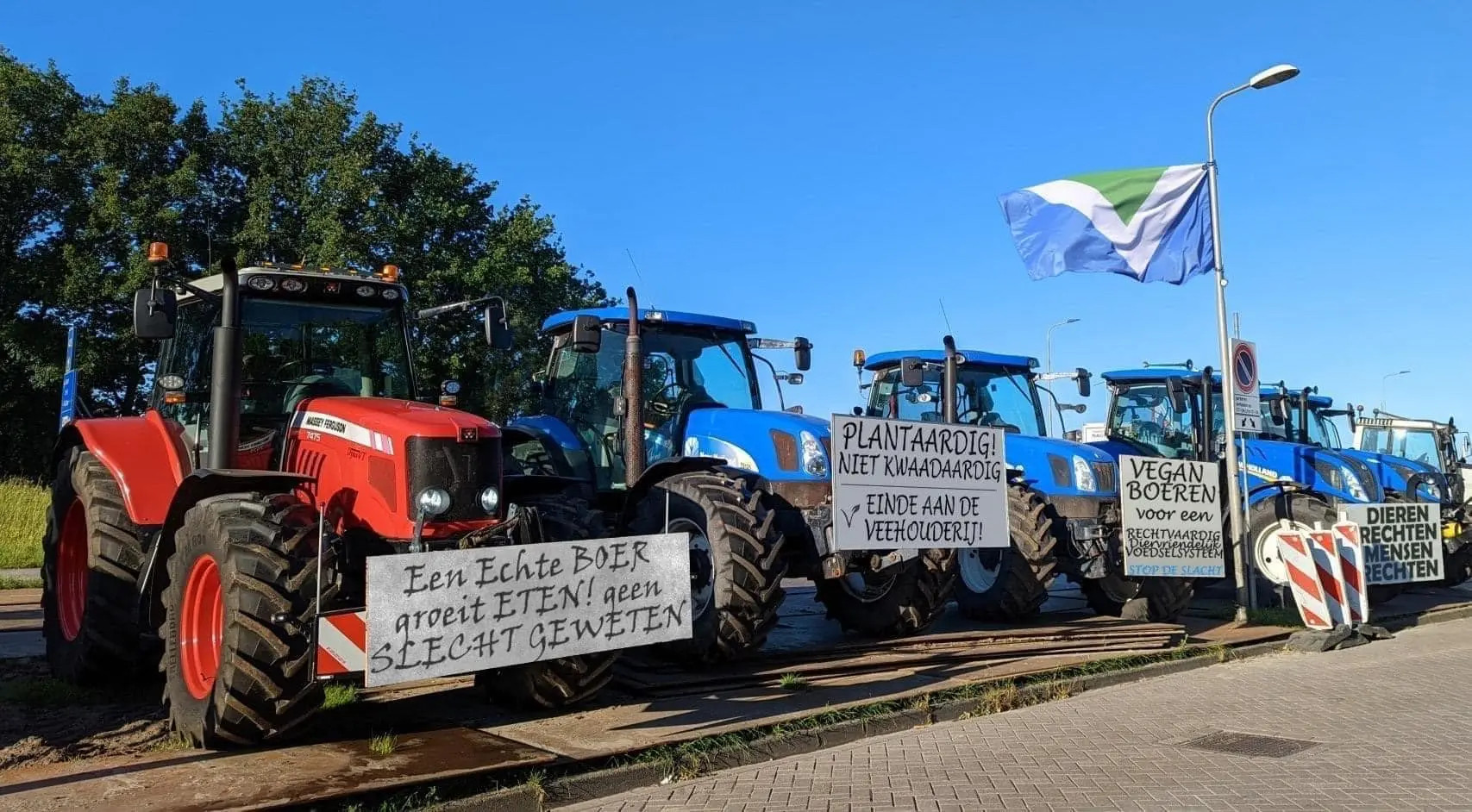
"A real farmer grows FOOD! Not GUILT." "An end to livestock farming." "Vegan farmers for a just, animal-friendly food system."
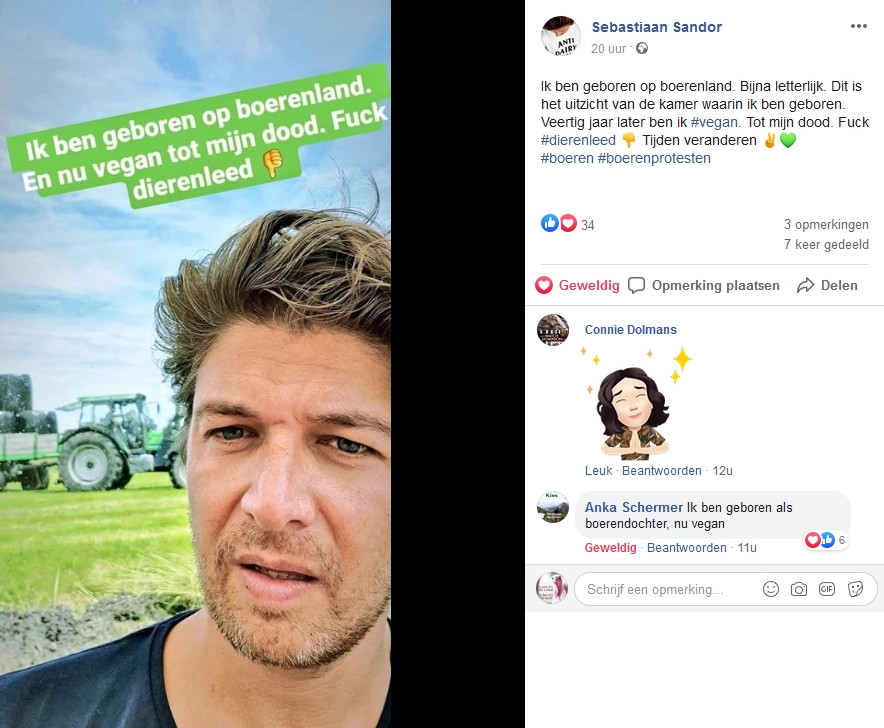
"I was born on farmland. And now vegan until I die. Fuck animal suffering." — Sebastiaan Sandor
Cow out and soy in for the Twente dairy farmers Bart and Tom Grobben. (source)
Raised on steak and charcuterie, but ex-butcher now starts 'vegan' catering: "My father first looked at me very strangely": Pieter Vanderper from Lichtervelde. (source)
There were many angry farmers and politicians last Friday after the presentation of the new nitrogen plans. But there are also farmers who chose a transition earlier and view the current crisis differently. Like the 26-year-old farmer Mark Venner from Baexem, who is converting the dairy farm, owned by his family for two centuries, into, among other things, a food forest. (source)
Dairy farmer becomes arable farmer
He and his wife sold their dairy cattle and phosphate rights because they were located in the built-up area of Oud Zevenaar and their land was in a Natura 2000 area. In Loil, between Didam and Arnhem, Theo Nieuwenhuis has been farming as an arable farmer for three years now. He is a pioneer. (source)
"Are his vegetables and fruits animal-free? Not entirely, says arable farmer Joost van Strien. Animal manure is often used to grow the crops.
That's why he switched to mowing fertilizers made from flowers and plants and became the first Dutch farmer to receive the international Biocyclic Vegan certification." (source)
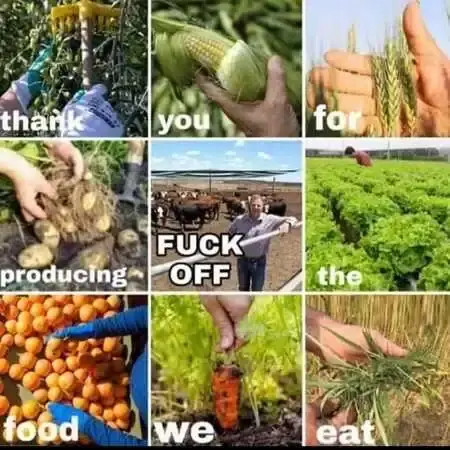
Toonders owns 27 hectares of pasture and corn land, on which he kept eighty dairy cows until three years ago. He also had 750 meat pigs. That is too small, and besides, I had no successor.
But the idea of cultivating giant grass appeals to my children. It is bred from elephant grass, which grows three and a half meters tall, and now grows up to six meters high. The harvest is intended to be used as raw material for building materials, plastics, and energy. … Market opportunities include high-quality applications such as bioplastics, biochar, and biofuels. (source)
Barn fires have been killing tens of thousands of animals each year for over a decade
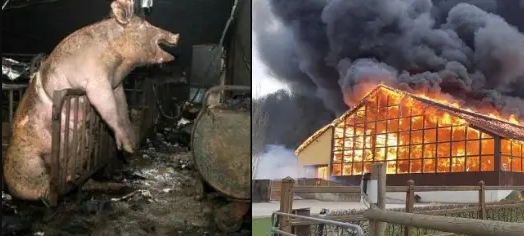
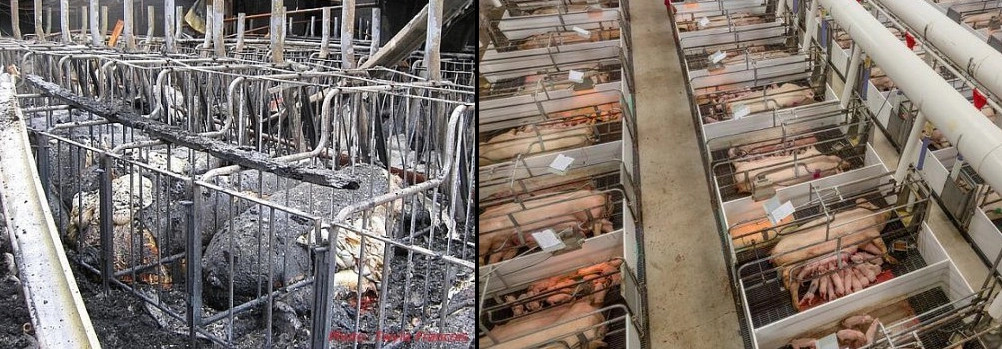
Animals burn alive, year after year. And nobody really intervenes.
Thousands of animals are burned alive every year in Dutch barns. The numbers are known. The causes too. And yet almost nothing changes.
In 2023 alone, there were 43 barn fires in the Netherlands. More than 37,000 animals died in these incidents. In 2022, the number of dead animals even exceeded 130,000—mainly due to a few large fires in intensive livestock farming. These are figures that would cause a national trauma if they involved human lives. But here they remain under the radar.
Barn fires occur every year. And nearly every year the same excuses are heard: it was the electricity, it was a device, it was spontaneous combustion, or "it can no longer be traced." Meanwhile, in many cases, no fire alarms are installed, let alone sprinklers or emergency plans. As if these animal lives hold no value at all.
No chance of escape
The animals locked up inside barns have no chance. They are kept by the hundreds, often thousands, in a closed space. No escape routes. No emergency exits. No supervision. Once a fire breaks out, it is already too late. Many die immediately from suffocation or heat, others are left with horrific injuries.
Animal Rights recently received footage from a barn fire in Belgium. Cows that survived were heavily burned and lying in the blazing sun. Their skin was loose, wounds open, lips burned away. No veterinary care, no shade, no shelter. As if their suffering didn't matter. (Photos and information from AR)
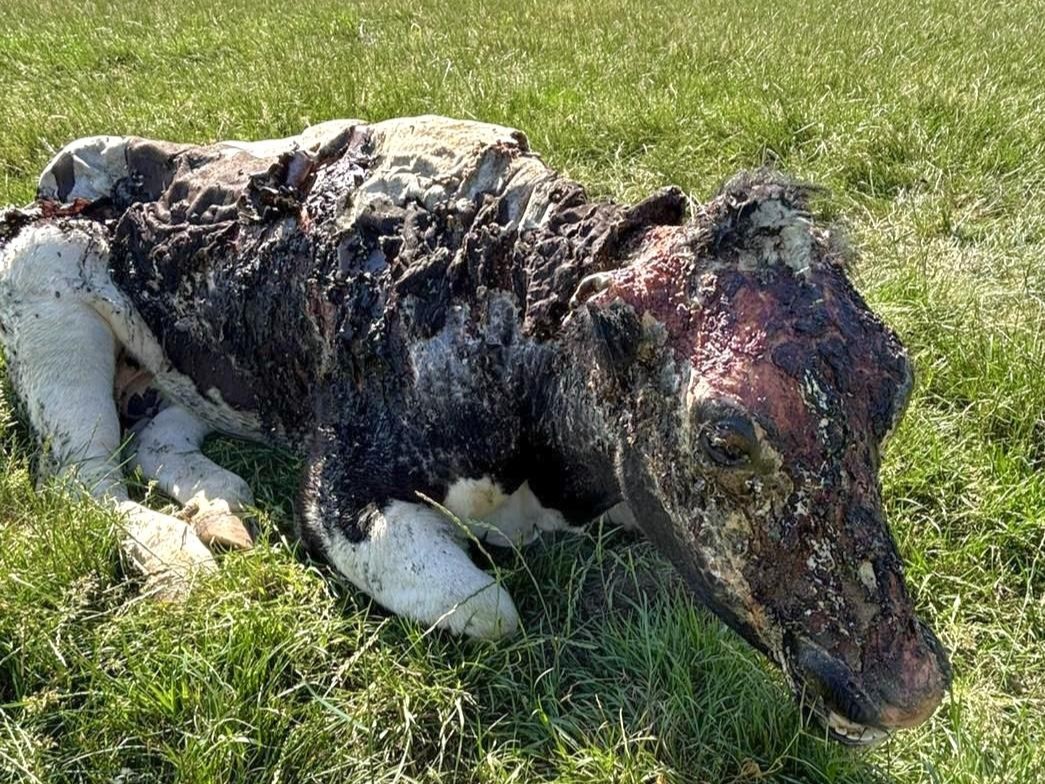
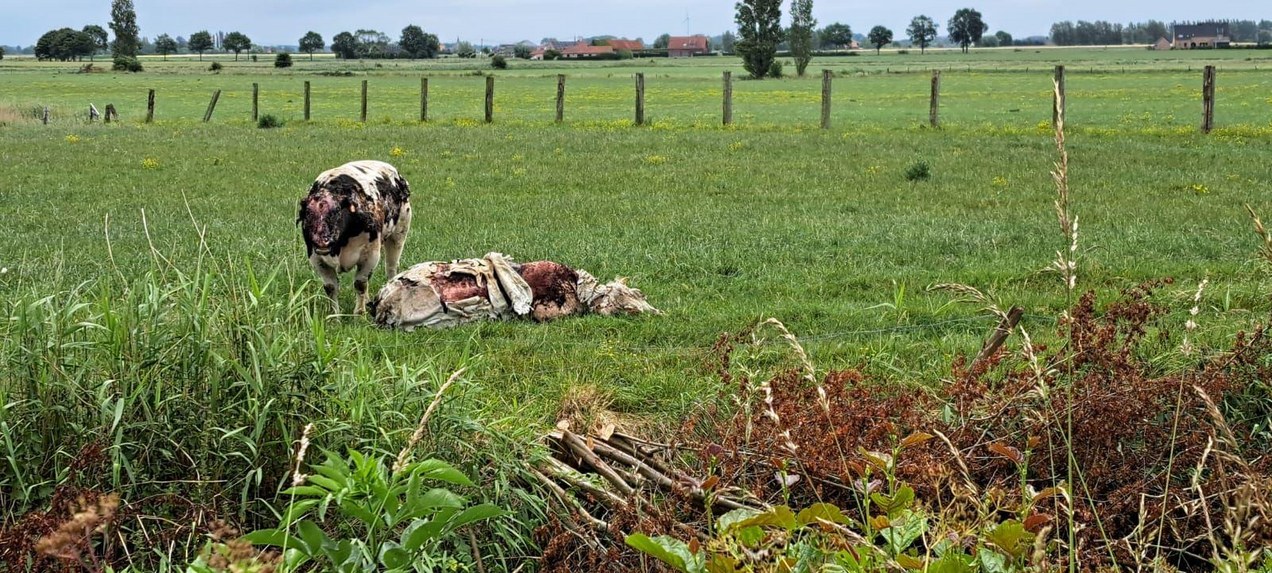
Still no obligation for fire alarms
What many people don't know: in the Netherlands, it is not mandatory to have a fire alarm in a barn. Yes, you read that right. In buildings housing thousands of living beings, there is no legal requirement for a warning system.
There are action plans, reports, evaluations—but concrete regulations? Those are lacking. Only new barns (built from 2014 onwards) must meet extra safety requirements. But what about the old barns? Often, nothing happens. No inspections, no controls, no protection.
Strange stories, silence, and shifting blame
Sometimes you read bizarre explanations: a wood stove was supposedly lit in the middle of summer in an old barn. Or a generator "spontaneously" caught fire. Machines are used during heat waves without supervision. As an animal lover, you wonder: who would do this to them?
But the media rarely focuses on the animals. Headlines always read: "Farmer loses everything in fire." Not: "Thousands of animals burned alive." As if their deaths are an afterthought. And what you sometimes hear on the street—that fires sometimes financially benefit farmers, or that insurers question the circumstances—this is never addressed.
So the system keeps running. Without responsibility. Without protection. Without empathy.
Let the numbers speak for themselves
In 2023: 43 barn fires, over 37,000 animals dead
In 2022: over 130,000 animals died in barn fires
In most cases: no fire alarms, no sprinklers, no escape possibilities. Common causes: electrical installations, work activities, unknown.
Regulations missing: no mandatory inspections, no fire safety standards for existing barns.
Animals deserve safety, just like every other living being. As long as the government doesn't enforce it and the industry stays silent, animal activists must keep speaking out. For those thousands of animals who had nowhere to go. If you want to stop this, you don't have to wait for rules or politicians—you can choose today: stop eating animals.

The Cruel Fate of Racehorses
While horse racing is marketed as sport and tradition, behind the scenes thousands of healthy horses are discarded each year when they're no longer profitable. Investigations have revealed that racehorses are being slaughtered on an industrial scale, with one Australian abattoir killing over 4,000 - despite claims of low numbers.
Many horses that once raced for human entertainment or profit are later neglected, mistreated, or killed - their bodies reduced to pet food or leather for sofas.
In the UK alone, around 1,000 ex-racehorses are slaughtered each year. Over 80 horses have died during Grand National events to date. These animals run, not out of choice, but out of fear and force. And when they stop earning, they're disposed of.
The Hidden Suffering of Farmed Rabbits
Rabbits are the third most farmed animals for meat globally, yet they receive almost no legal protection in many countries. In industrial rabbit farming, these sensitive animals are typically kept in tiny wire cages with less than one A4 sheet of space per rabbit — barely enough to turn around or stand upright.
According to reports by Compassion in World Farming and Eurogroup for Animals, over 330 million rabbits are farmed each year in the EU alone — most in battery-style cages with no enrichment, solid flooring, or outdoor access.
They cannot hop, dig, or display natural behaviors. Many suffer from painful injuries, extreme stress, and are slaughtered at just 8–12 weeks old.
👉 Rabbits are social, intelligent beings who feel fear and pain. Don't support industries that treat them like disposable objects.
This video is age-restricted and only available on YouTube because it shows animal cruelty.
You won't see this kind of warning on vegan videos, because veganism involves no animal suffering for clothing or food.
Do not buy fur or 'fake fur'
Many items labeled as "faux fur" are in fact made from real animal fur - often from rabbits, raccoon dogs, or cats - especially in fast fashion. Mislabeling is shockingly common, and real fur is sometimes cheaper to produce than quality synthetic alternatives. Investigations in the UK, EU, and U.S. (e.g. Humane Society International) have repeatedly found real fur falsely labeled as "faux." Brands know consumers want cruelty-free fashion - but that doesn't mean they're honest. They profit from confusion.
👉 If you don't want to support the fur industry, avoid all fur - even so-called "fake" fur.
Don't risk it. Don't wear animal cruelty.

The Cruelty Behind Goose Down
That soft, luxurious down filling your jacket, bedding, or pillow often comes at a horrifying cost. In the down industry, geese are brutally live-plucked-a process where handfuls of feathers are ripped from their skin while they are still conscious. This causes extreme pain, open wounds, and immense fear. Many geese are plucked multiple times before being slaughtered. Investigations by PETA and Four Paws have shown that even in supply chains labeled as "ethically sourced" or "certified," live-plucking and force-feeding still occur.
Geese are gentle, intelligent animals who form deep social bonds and feel pain just like any pet would. Choose cruelty-free alternatives. Down isn't a byproduct — it's a result of suffering.
Angora wool comes from rabbits - but not without pain. These gentle animals are often violently restrained and plucked alive, screaming in agony as their fur is torn from their skin. This happens every few months, leaving them bloody, stressed, and terrified.
UGG boots may feel soft on the outside — but inside is a story of suffering. They are made from real sheepskin, meaning a sheep had to die for each pair. These animals are often subjected to rough handling, brutal shearing, and slaughter in the wool and meat industries. UGGs don't just use the wool — they use the entire skin, with the fleece still attached.

The Reality of Foie Gras
Foie gras - meaning "fatty liver" in French - is produced by force-feeding ducks or geese several times a day through a metal tube shoved down their throats. This cruel process, called gavage, causes their livers to swell up to 10 times their normal size, leading to pain, organ failure, and a slow, agonizing death.
Numerous undercover investigations have revealed birds panting in distress, too sick to stand, some bleeding from the beak or covered in vomit. Many die before slaughter from ruptured organs. Foie gras has been condemned by veterinarians and banned in multiple countries, yet the industry continues where profit outweighs compassion.
Hunting: Cruelty Disguised as Sport
In a world where wild animals are already losing their natural habitats to deforestation, urban expansion, and climate change, hunting adds yet another brutal blow.
Killing for sport is not conservation - it is domination. These animals are not overpopulating; they are barely surviving. Hunting does not bring balance, it brings bullets to beings who simply want to live. When you strip an animal of its home and then of its life, it's not tradition - it's betrayal. Real strength is protecting the vulnerable, not pursuing them with a weapon.
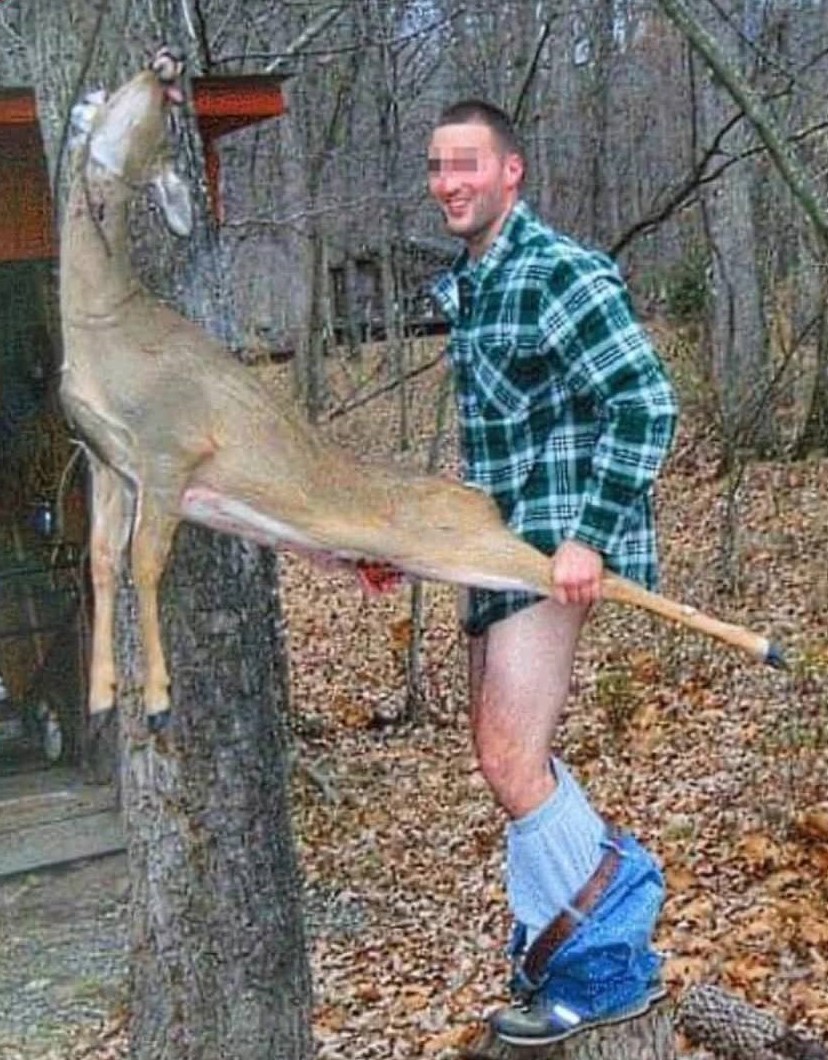
When Hunters Regulate Wildlife
Preston Farrior, a known trophy hunter, has been appointed as a commissioner on the Florida Fish and Wildlife Conservation Commission. On August 13, he will vote on whether to reinstate the controversial black bear hunt in Florida. This is yet another example of a troubling pattern: individuals with pro-hunting agendas being placed in positions of power where they are expected to protect wildlife, not exploit it. Allowing trophy hunters to influence conservation policies is a clear conflict of interest - and it's wildlife that pays the price.


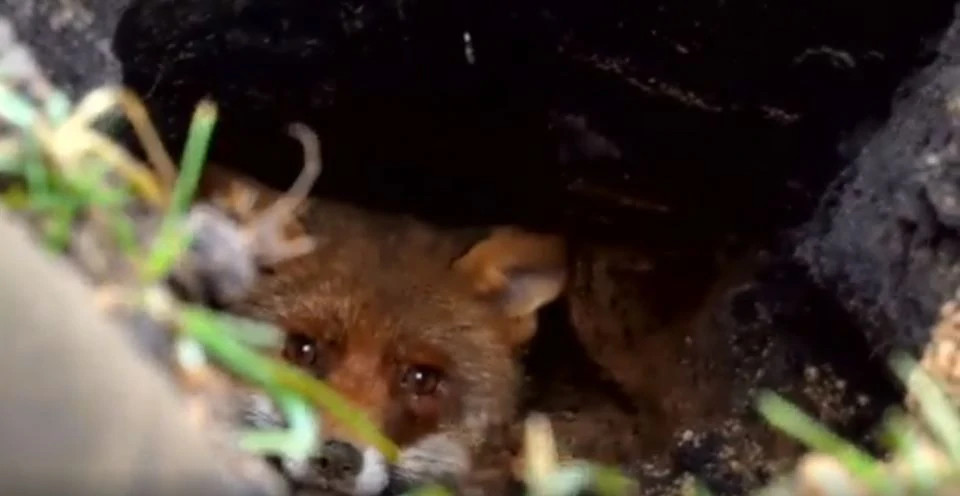
In an episode of JachtTV on youtube you can see a hunter of scared animals named named Björn van de Veen uit Friesland shows how you dig out a defenseless and fearful fox, let it escape and shoot at close range. And that with four people. ..
Hunters in the Netherlands are also known to kill cats, and dumping them without looking if they have an owner.
In 2007, Four Paws International rescued the former dancing bear from the zoo of Shumen in Bulgaria. Since then Lady M has been living at the Dancing Bears Park Belitsa, which they run together with Fondation Brigitte Bardot. Here she is in 2020 amidst the Valentine's Day suprise from the Four paws team. het Four Paws-team.
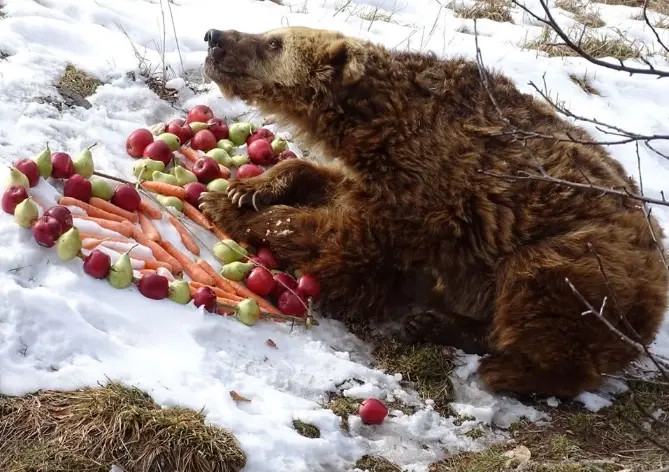
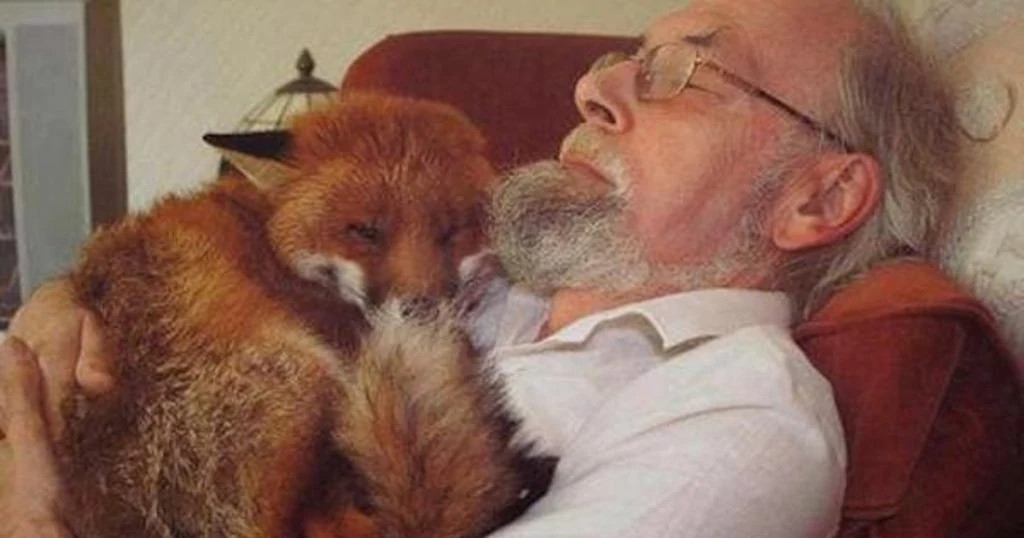
Man saved Fox seriously injured and found his new best friend. On the
side of a highway, a red fox named Cropper was discovered and saved at
Turnbridge Wells in England by The Fox Project. The rescue couldn't let him return to the wild but then a retired engineer, Mike Trowler, appeared.
See also:
Deer Hunter turned animal rights activist
https://www.instagram.com/emptycages.vegan
Live Export: 60 Years of Hidden Cruelty
For over six decades, the horrifying treatment of animals on live export ships has been kept in the shadows. Every year, millions of animals — mostly sheep and cattle — are crammed onto ships and sent across oceans, often for weeks at a time, facing unimaginable suffering.
In the sweltering heat, many animals collapse from dehydration and exhaustion. Some are literally cooked alive, dying slowly in temperatures exceeding 40–50°C (104–122°F) in their own waste.
They go without food or clean water, with some too sick or injured to stand, trampled to death by others. Illness, untreated wounds, and panic are common — and when they arrive at their destination, brutal slaughter often awaits, without any of the protections they'd receive in their home country.
Investigations (such as by Animals Australia and independent whistleblowers) have exposed this suffering again and again — yet the trade continues under a veil of secrecy and profit.
There is no "humane" export. Only silence, suffering, and the sea.
The video here showing animals being cruelly transported and exploited is hidden from view, yet the leather shoes made from their suffering are proudly displayed and sold.
Fish are not vegetables. They are animals - with brains, nervous systems, and the capacity to feel pain. Neuroscientific research confirms that fish experience not just pain, but also fear, stress, and even have memories.
When pulled from water, fish suffocate slowly, often enduring up to 20 minutes of agony before dying. Their gills collapse, and their organs fail as they struggle for oxygen — a terrifying and painful death.
Some argue that "plants feel pain," but this is false. Plants have no brain, no central nervous system, and no consciousness — they cannot suffer.
Fish Feel Pain — And Fish Are not Vegetables
Welfare on Paper, Cruelty in Practice
Claiming that animal health and welfare is a pillar of their standards, an aquaculture certification company is allowing companies to continue cutting the eyes off of shrimps until the end of 2030. This despite some companies moving away from the egregiously inhumane practice, and "[a] number of grocers ... eliminating the use of the practice within their shrimp supply chains". Stating that it "stands ready to support the global aquaculture industry at all times," a company rep announced: "it's become clear that eyestalk ablation should no longer be considered among the best practices for shrimp aquaculture." How insightful.
Rather than doing it for the sake of the shrimps', the company said it should be done "in response to consumer and retail demand."In the meantime the company continues to certify such cruelty. Source (from Fish Feel FB page)
Sexual Abuse of Animals: From Ancient Rituals to Modern Industry
Sexual violence against animals is not an isolated issue caused by a few disturbed individuals. It has roots in antiquity, still occurs in ritualistic and religious contexts, and takes place daily within the so-called "normal" livestock industry.
Pagan Rituals and Mythology
In ancient cultures and religions, sex with animals regularly appears in symbolism, mythology, and sometimes in ritual practices.
The Greek god Pan is often depicted as a man-goat hybrid, associated with sexuality, fertility, and nature. In some classical sculptures, Pan is even shown engaged in a sexual act with a goat.
The myth of Leda and the Swan, in which Zeus rapes a woman in the form of a swan, is a well-known example of sexual fusion between gods (in animal form) and humans.
In Norse mythology, Loki transforms into a mare and mates with a stallion.
Prehistoric rock art in places like Sagaholm (Sweden) and Kanozero (Russia) also includes depictions of men appearing to engage sexually with animals such as horses or reindeer. Some researchers interpret these scenes as ritualistic or sexual symbolism.
Religious Statements
The Islamic scholar Zakir Naik has cited a Sahih Hadith stating that a man is allowed to have sex with a sheep or goat to control his sexual urges, on the condition that the animal is then killed and not eaten by his community.
Notably, in March 2015, Zakir Naik was awarded the prestigious King Faisal International Prize (Service to Islam) — one of the highest recognitions in the Islamic world. The award acknowledged his "exceptional service to Islam," particularly as a globally recognized preacher (via Peace TV) and an authority on comparative religion.
The Livestock Industry: Institutionalized Abuse
What many people don't know is that sexual acts with animals also routinely occur in industrial animal farming — under the guise of "production."
Female cows, pigs, and sheep are artificially inseminated, a process that involves inserting a human arm into the animal's rectum to position the cervix, while a tube delivers semen into the vagina.
This semen is collected from male animals who are masturbated using artificial means — often involving phantom mounts or electroejaculation.
Within the industry itself, the term "rape rack" is actually used to describe the steel restraint in which the female is held during insemination.
Although legally permitted, there is morally little distinction between these practices and sexual exploitation. The animal has no choice, no voice, and is treated purely as a commodity or object.
📚 Sources (simplified and summarized):
-
Engendering North European Rock Art – Lahelma & Goldhahn (via ResearchGate)
-
Zakir Naik quote – reported via Kreately.in
-
Depiction of Pan and goat – discussed on Reddit: AskHistorians
-
Insemination practices – documented by PETA, Animal Equality, and The Guardian
Sexual violence against animals worldwide: a growing problem
In several countries, sexual violence against animals is increasing at an alarming rate. In Europe, so-called bestiality brothels have been discovered in countries such as Germany and Denmark – places where people can pay to have sex with animals. Although illegal in many nations, these practices are often tolerated or take place in legal grey areas.
In Australia, more than 30,000 reports of sexual abuse against kangaroos were filed in 2015, along with thousands of additional cases involving koalas and wombats. According to local activists, this is likely just the tip of the iceberg.
In his book Bestiality and Zoophilia: Sexual Relations with Animals, Anthony L. Podberscek describes how cities like Beirut (in the 1960s) and parts of Syria as early as 1933 were known hotspots for sex with animals.
Unfortunately, there are images and services circulating on the internet where monkeys and other animals are deliberately mistreated, sometimes even on demand. These horrific practices reveal how cruelty to animals occurs worldwide, often hidden from view. It is essential to raise awareness and unite in the fight against this injustice, because every animal deserves respect, safety, and protection. Animal abuse is a global problem that requires our collective attention and action.
Hayek Hospital: The World's First Vegan Hospital
Hayek Hospital in Beirut, Lebanon, opened in March 2021 as the very first hospital in the world to serve exclusively plant-based, vegan meals to its patients. This unique choice is based on scientific evidence showing that plant-based nutrition can contribute to better health and support recovery. At the same time, the consumption of red and processed meat has been linked to an increased risk of various chronic diseases.
Hayek Hospital's focus is on supporting healing through nutrition, a vision that traces back to Hippocrates, the founder of modern medicine. Hippocrates, who lived in ancient Greece, is often quoted saying:
"Let food be thy medicine and medicine be thy food."
Hippocrates himself did not eat meat and emphasized the importance of nutrition as an essential part of health and recovery.
To this day, doctors worldwide take the Hippocratic Oath, committing themselves to ethical care and the well-being of their patients — a tradition that acknowledges the role of nutrition and prevention in medicine. Hayek Hospital embodies this ancient wisdom in a modern context by placing healthy, plant-based nutrition at the center of medical care.
👉 Must-See Documentaries





